
Title: On the track of Ulysses; Together with an excursion in quest of the so-called Venus of Melos
Author: William James Stillman
Release date: December 26, 2019 [eBook #61025]
Most recently updated: October 17, 2024
Language: English
Credits: Produced by Turgut Dincer, Stephen Hutcheson, and the
Online Distributed Proofreading Team at http://www.pgdp.net
(This file was produced from images generously made
available by The Internet Archive)

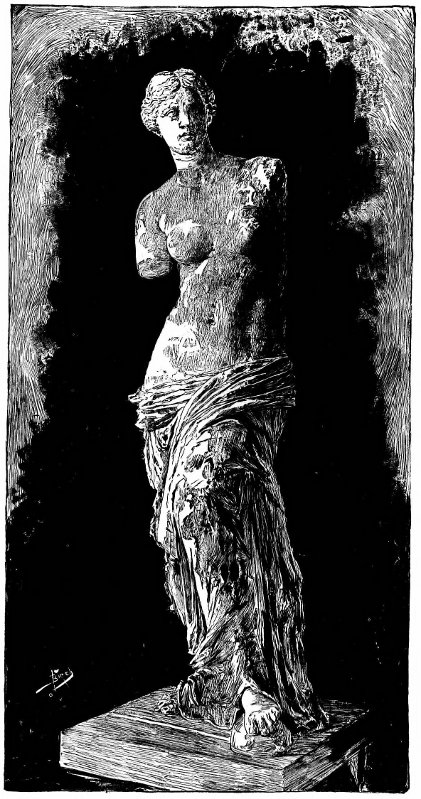
TOGETHER WITH
AN EXCURSION IN QUEST OF THE SO-CALLED VENUS OF MELOS
TWO STUDIES IN ARCHÆOLOGY, MADE DURING A CRUISE AMONG THE GREEK ISLANDS
BY
W. J. STILLMAN
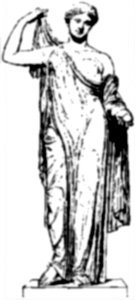
BOSTON AND NEW YORK
HOUGHTON, MIFFLIN AND COMPANY
The Riverside Press, Cambridge
1888
Copyright, 1887,
By W. J. STILLMAN.
All rights reserved.
The Riverside Press, Cambridge:
Electrotyped and Printed by H. O. Houghton & Co.
In times when the feverish ambition of our people so generally climbs to distinction by ways offensive to the true intellectual and moral life, and when we find the old standards of human dignity so often forgotten; it renews one’s faith in the future of humanity to meet a man whom neither the “Olympian dust” nor that of California has been able to deflect from that line of perfect rectitude of life which, if existence is to be anything but an indecent scramble, we must recognize as entitling the man who holds it, to the highest respect of his fellow-men. When besides this claim to our respect he has been able to maintain undimmed the lustre of a name such as you bear, the distinction is still brighter. If therefore my insignificant tribute were only as the dust which, catching the sunshine, males it visible, let me offer this dedication in recognition of the true standard of nobility as I know it in your father’s son.
W. J. STILLMAN.
The series of papers herewith committed to the more or less permanent condition of book form were originally (less some development of their arguments) printed in the Century magazine, being the results of an exploring visit to Greek lands taken as a commission for that periodical. I have sought in them to solve, in a popular form, certain problems in archæology which seemed to me to have that romantic interest which is necessary to general human interest; and while necessarily, in such a study, dealing much with conjecture, I have not ventured to assume anything which I am not satisfied is true. The problem of the so-called Venus of Melos is one of those which archæology has fretted over for two generations, and I cannot pretend to have offered a solution which will command assent from the severely scientific archæologist; but I have an interior conviction, stronger than any authority of ancient tradition to my own mind, that that solution is the true one. I do not wish it to be judged as a demonstration, but as an induction in which a kind of artistic instinct, not communicable or equally valuable to all people, has had the greatest part; and, for the rest, I am satisfied to let it be taken by the rule of “highest probability,” by which we solve to our satisfaction, more or less complete, problems of the gravest importance—a rule, indeed, which is for many such the only standard of truth. In archæology, vi as in some other inexact sciences, opinion has with most people greater weight than it always merits, but it should have weight in proportion to the knowledge its originator may have of his subject. As to this I have done all that any man can to penetrate to the material which exists for forming an opinion, and I rest in the sincere conviction, sustained through a study of many years, that the so-called Venus of Melos is really the Niké Apteros of the restored temple dedicated to that goddess.
I must acknowledge the courtesy of the proprietors of the Century magazine in according me the use of the admirable illustrations accompanying my text, which were put on the blocks by Harry Fenn from my own sketches or photographs.
W. J. STILLMAN.
New York, September, 1887.
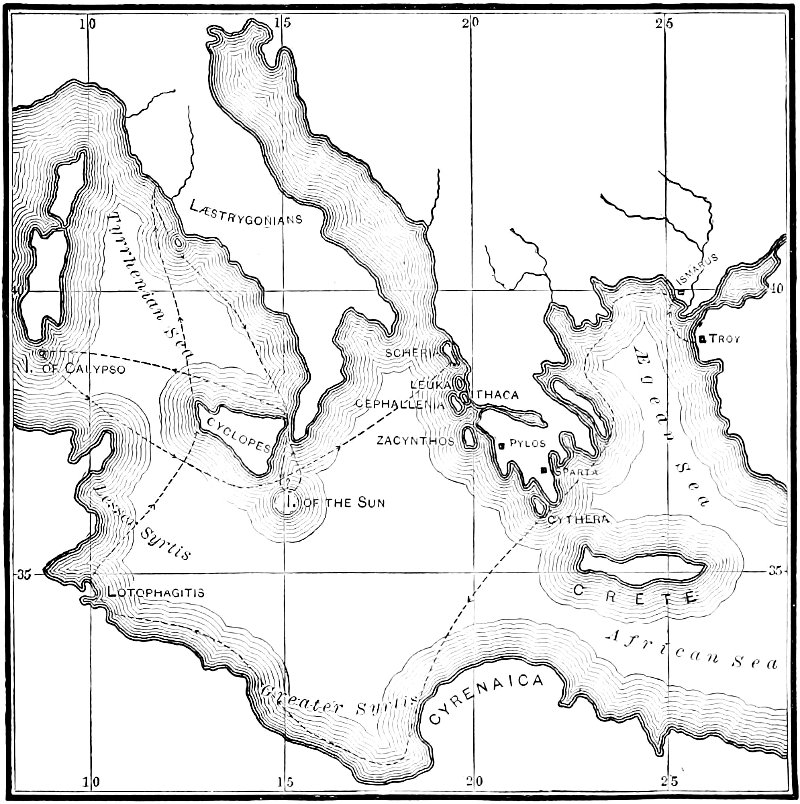
THE ROUTE OF ULYSSES.
What remains for exploration to find on the surface of our little earth? The north and south poles, some outlying bits of Central Africa, some still smaller remnants of Central Asia,—all defended so completely by the elements, barbarism, disease, starvation, by nature and inhumanity, that the traveler of modest means and moderate constitution is as effectually debarred from their discovery as if they were the moon.
What then? I said to myself, searching for adventure. Let us begin the tread-mill round again and rediscover. I took up 2 the earliest book of travel which remains to us, and set to burnish up again the golden thread of the journey of the most illustrious of travelers, as told in the Odyssey, the book of the wanderings of Odysseus, whom we unaccountably call Ulysses, which we may consider not only the first history of travel, but the first geography, as it is doubtless a compendium of the knowledge of the earth’s surface at the day when it was composed, as the Iliad was the census of the known mankind of that epoch. Spread on this small loom, the fabric of the story, of the most subtle design,—art of the oldest and noblest,—is made up with warp of the will of the great gods, crossed by the woof of the futile struggles of the lesser, the demi-gods, the heroes, and tells the miserable labors of the most illustrious of wanderers, the type for all time of craft, duplicity, and daring, as well as of faith and patient endurance.
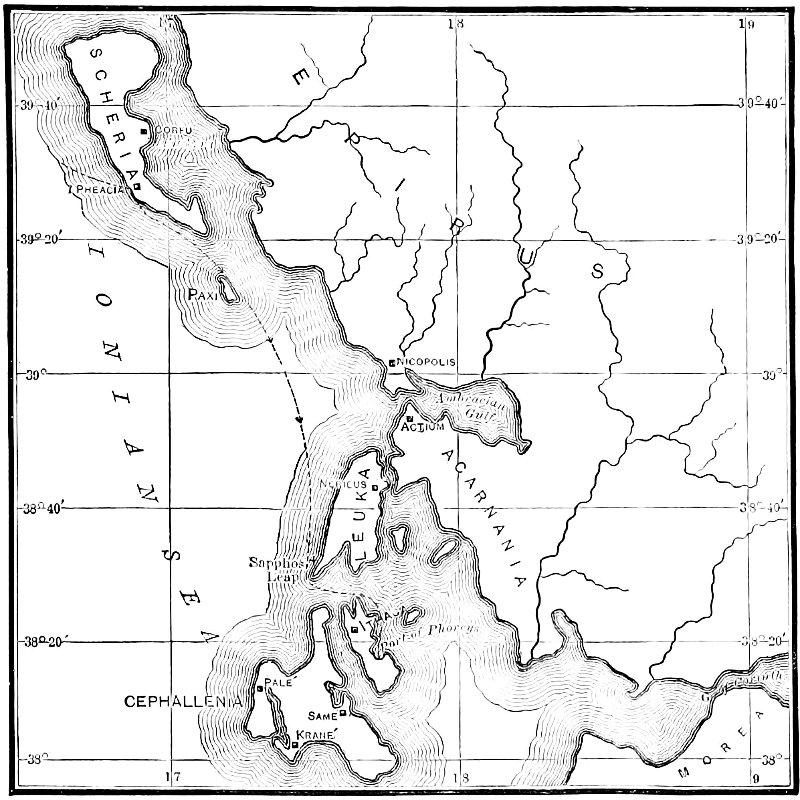
ITHACA AND ADJOINING ISLANDS.
But as Homer’s humanity mixes by fine degrees with his divinity, so his terra cognita melts away into fairy-land, and we must look for a trace written on water before landing on identifiable shores. The story opens finding Ulysses the prisoner of Love and Calypso, in Ogygia, a fairy island of which the Greek of Homeric days had heard, perhaps, from some storm-driven mariner, or which may be a bit of brain-land. The details of the story make it very difficult even to conjecture where Ogygia was, if it was.[1] How Ulysses leaves the island alone on a raft is told by the poet in the fifth canto; how he got there the hero recounts in the narration to Alcinoüs in Phæacia. Leaving Troy, he stops at Ismarus, a town on the coast of Thrace, which he surprises and sacks; but, repulsed by the inhabitants of the lands near by, rallying to the defense, and visited by the wrath of the gods for his impiety, he is punished by a three days’ gale, and reaches Cape Malea, where, unable to stem the north wind which still persecutes him, he runs past Cerigo down to the African coast, which he reaches in nine days. Here we enter into semi-fable.[2] The Lotophagi seduce his men with their magic fruit which brings oblivion, and he is obliged to fly again. This time he goes north, and comes to an island which lies before the port of the Cyclops, a terrible race: giants with one eye, and cannibals, over whose land the smoke hangs like whirlwinds—evidently 4 Sicily. This little island, where the Greeks debark, is not to be identified, but is probably one of those to the west of Sicily, called later the Ægades. Thence, after the famous adventure of the Cyclops’ cave, one of the poet’s most marvelous inventions (since every detail shows that there was no positive knowledge of the land or its people—only a fantastic tradition), they fly and arrive at the floating island of Æolus, still a creation of mythology, and thence to the shores of the Læstrygonians, another fabulous, man-eating race, in whose land the days are separated only by a brief pretense of night; escaping thence with his single ship and crew, Ulysses arrives at Æa, the island of Circe, from earliest classical times identified with Cape Circeo, between Naples and Cività Vecchia. Circe sends the hero to the land of the Cimmerians,[3] where time touches eternity, and the shades of the dead come to visit the unterrified living; and here Tiresias, the dead soothsayer, tells the future wanderings of the Ithacan chief. Again, returning to Æa, he is redirected toward home through the strait where Scylla and Charybdis menace his existence. This we recognize by later tradition as the Straits of Messina, but the fabulous so dominates the slight element of geography in it, that it is clear that Homer never passed that way, and gained his knowledge only from far remote report; while his second passage—after the sacrilege committed in the Island of the Sun—through the straits, is puzzling, and the recital makes it clear that till Phæacia was reached the poet was not in terra cognita.
The indications are hardly reconcilable with the map. Leaving Circe to go home, he passes the straits, and stopping at the Island of the Sun, his comrades commit a sacrilege which leads to their destruction and his being driven back to 5 Ogygia through the straits, a solitary survivor. But on his departure for Phæacia direct, he does not pass again through the straits, evidently returning to the south of Sicily.
Released by Calypso, he goes on a raft with the sailing direction to keep the Great Bear, “which is also called the Wain,” on his left,—that is, he sails eastward, and for seventeen days splits the waves, and sees on the eighteenth the wooded mountain of the island of the Phæacians, the Scheria of the ancients. The continuity of tradition and the consistency of the narrative leave me no doubt that this was our Corfu, the uttermost of the lands positively known to the geography of that day. The actuality of Scheria has been disputed by certain German critics, who will have it that all the local allusions of the Odyssey are imaginary. But in the Æneid, when Æneas is going to Butrintum, which is now Butrinto, opposite Corfu on the Albanian coast, he says that no land was in sight except Scheria. This makes it certain that in Virgil’s time there was no question on the point.
Already in sight of Scheria, Ulysses is overtaken again by the wrath of Poseidon, who unchains on him all his tempests; and, his raft wrecked in open sea, himself swept away from it into the mountainous waves, he regrets not having found a glorious death before Troy, seeing an inevitable and unhonored end before him, with no funeral rites to give his soul peace. Leucothea, the white goddess, throws into the black warp a silver thread, and brings the story into new light and color. She gives him an amulet which, by its magic, carries him through the last of his grave perils, and preserves him when, with a great and wrathful burst of wind, Poseidon disperses the timbers of his raft and leaves him floating in the yeasty sea. He seizes on one of the timbers and hopefully strikes out for the land. Athene comes once more to his aid. She chains all the winds except Boreas, which, wafting him for two days and nights to the southeast, gives place to a perfect 6 calm. Ulysses, raised on the summit of a huge wave, looks out and sees the land. But it is a terrible, rock-bound coast. “He hears the roar of the waves that break on the rocks, because the shock of the great waves against the bare cliffs sounds fearfully, and the sea, far and wide, is covered with foam. But there is no peaceable roadstead, no port, safe refuge of ships; everywhere high, mountainous rocks and cliffs.” He appeals to the gods for pity, and just then, “while he turns these thoughts in his spirit and heart, an immense wave throws him on the bare shore. Then his flesh would have been torn and his bones broken if Athene had not inspired him. With both hands he clutches the rock and embraces it with groans until the wave had withdrawn. He in this way escapes death, but the return of the wave falls on him, strikes him, and withdraws him into the open sea. He, emerging from the depths, more prudently coasts along, swimming until he can find an opening in the rocks where he may enter, and finally perceives the mouth of a river. He offers a prayer to the river god, and is heard and peacefully received by the peaceable wave, which lands him on the sandy shore.” The whole of the finale of the fifth book is grand and imaginative, especially in the description of the stormy sea and the condition of Ulysses as he sinks on the hospitable sands exhausted, half dead from his long struggle and his two days’ and nights’ swim, sustained only by one of the logs of his raft;[4] but what to my present purpose is of most significance is the striking description of the west coast of Corfu and the unmistakable evidence of the mythologist giving way to the traveler. Here we strike the veritable track of Ulysses, and here begin our researches. To reach this point all the commerce of the Levant aids us—steamers from Trieste, Brindisi, Naples, Patras, Malta, etc.
Here I found fit to my purpose a little yacht of twelve tons, cutter-rigged and Malta-built, the Kestrel, with whose master and owner I made my bargain, namely: he was to obey all my reasonable orders for any voyage within the two archipelagos, find his ship and crew of two sailors in all they needed for service and safety, do my cooking, and insure himself, for the sum of fifteen pounds sterling a month for three months; and while he was putting in stores, fitting new cables to his anchors, and burnishing up a bit, we began to inspect Scheria.
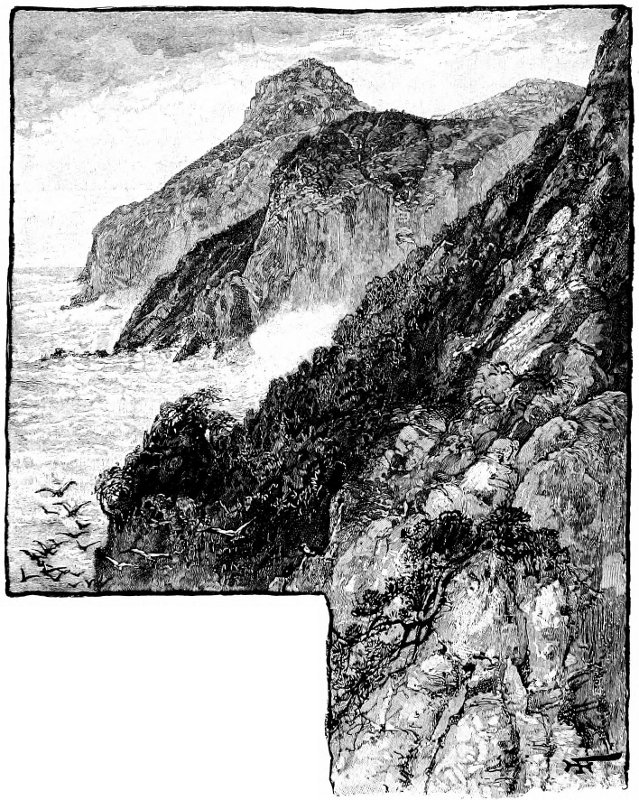
WEST COAST OF SCHERIA.
The popular tradition of to-day fixes the landing of Ulysses near the actual city of Corfu, and an island is pointed out as the ship turned to a rock; while the spot where he landed, and the scene of that most charming of all the episodes of his wanderings, the meeting with Nausicáa, is put at the “one-gun battery,” just south of the harbor of Corfu. Nothing could comport less with the description of the Odyssey. The Channel of Corfu, dividing the island from Epirus, is a land-locked basin in which no such storm could arise as Ulysses encountered, and along which no such rocks exist as are described in the poem. The seventeen days’ drift from the westward before the tempest, and the next two days after it, wafted by Boreas, show that he was in the open Adriatic, and coasting along the rock-bound western coast of Scheria to find an inlet where he might enter. The illustration shows the character of this coast in entire concordance with the Odyssey; and there is near the spot from which my view of the west coast of Scheria is taken, a convent (which is visited by all the tourists who, having some days in Corfu, care for the most picturesque part of the island), and which by its name, Palæcastrizza, shows that it stands near the site of some ancient city or fortress, as the term “Palæcastron” is never applied by local tradition to any construction not belonging to the classical or archaic epochs. Even Byzantine ruins never receive the epithet “palæos.” No trace is now to be found of any prior structure near the convent, which, while it probably has some relation to an antique site, certainly is not on that of the city of Alcinoüs, which must have been farther south where the shore breaks down to a plain. There used to be in the island an old antiquity-hunter who brought from time to time to sell clandestinely in the city, objects of gold and terra-cotta, vases, etc., dug up at a site which only he seems to have known, and of which he would never disclose the location. On inquiring for him on this my last visit to Corfu for these researches, he was 9 not to be heard of. All that we had learned from him was that the ruins of which he knew and where he excavated in secret were somewhere on the western coast, which corresponds to my hypothesis that the capital of Alcinoüs was there.
There is something so unpractical in the Greek laws on the subject of excavation and exportation of antique objects, that it is to be hoped that the shrewd common sense of the people will ere long see their impolicy. Excavation without permission from the Government, even on one’s own land, is forbidden, which is not unreasonable considering all things; but even when permission is accorded or when objects are found by chance, the Government practically confiscates the find when the finders are feeble, and levies a tax of half the value when they are not. Everything, therefore, is done in secret, and exportation by contraband is the only possible manner of profiting by one’s good fortune. The peasant who finds an antique site carefully conceals it; and the objects he finds, instead of enabling the archæologist to classify the antiquities by reference to their provenance, are sold to some one who removes them from the country, and so all clue is lost to their true archæological position. As I shall have to show in the course of these articles, grave loss to the science of archæology sometimes occurs in this way. In this particular instance the loss to me is the being unable to identify, with any probability, the place where or near to which Ulysses landed, and where the classic meeting with Nausicáa took place. When we get to Ithaca we shall find that the author of the Odyssey knew well every foot of land he describes; and the scene of Ulysses’ disaster, already translated, accords so well with the actual topography that it is difficult to suppose that a mere inspiration dictated it, and that the author was not well acquainted with the island of Scheria, whose capital was Phæacia.
The claim of the city of Corfu to be the site of the ancient Phæacia rests on nothing but the fact that it is the only city in the island; but the ever-tranquil bay on which it lies, and the fact that Ulysses, instead of searching for a place where he could land, would rather have had to search for a place where he could not, shows conclusively that no part of the eastern coast is entitled to the honor. The “one-gun battery,” where local tradition places his landing, is perhaps the least likely point, as no running stream is to be found near there. The lake, which is now suggested as the tranquil water in which Ulysses came to land, must then have been much larger than at present, and now in nowise resembles a river: it is the half-filled arm of the sea into which a wide basin of marshy land has been for centuries draining, but into which no watercourse leads, and the view seen from above the “one-gun” needs scarcely a commentary to show its entire incompatibility with the Odyssey.
The capital of Alcinoüs was, we are told by Homer, founded by his father Nausithoüs. His people were formerly inhabitants of Hyperia, “near the Cyclops,” and were by these latter so ravaged and overborne that they emigrated to Phæacia. The generally accepted location of the Cyclops in Sicily suggests that Hyperia was probably there or in Italy; and that the Phæacians may have been related to the Siculi; since the Pelasgi, who invaded Italy from the north, and, uniting with the Umbri, spread over the whole of southern Italy, expelling the aborigines, are continually confounded by the earliest traditions with the Cyclops. As, from all we know, the Tyrrhene Pelasgi were the earliest metal-workers in that part of Europe,[5] and as the Cyclops, the children of Hephaistos, 11 the great metal-worker, are a mythological idealization of a race of smiths who had a habit of covering the eyes, for protection from sparks, with a screen in which a single hole was cut to see through, which was transmogrified into a single eye in the middle of the forehead, there is nothing unlikely in the inference that the Pelasgi and Cyclops were identical, and that the Phæacians were refugees from the conquest of southern Italy by that formidable people. That they were not Greeks we know by their absence from the catalogue of the “Iliad,” where all the Hellenic tribes were recorded in their places in the league.
The Corfiotes of to-day boast of descent from the Phœnicians, and certainly they are not to be measured by the same standard as the Greek race in general. Their reputation for dishonesty has given rise to a Greek proverb, which relegates a person of more than usual craftiness and bad faith to the “Corfiotes.” “He behaves like a Corfiote” is the greatest reproach the continental Greek can bring against a man who is too clever in business matters. In character as well as history the Corfiote has little in common with Greece. As he had no place inside the line drawn around the Hellenic world at the great critical, even if mythical, epoch assigned to the siege of Troy, so in his latest history he has always maintained a position more or less apart. Diodorus Siculus makes the Homeric name of the city, Phæacia, to have been derived from Phæacus, son of Poseidon, and places his reign contemporary with the Argonauts, as Phæacus protected Jason against the king of Iolcus when, returning from Colchis with Medea, he took refuge at Scheria. Mythology begins with it in the combat of Zeus and Poseidon in their struggle for supremacy in the government of the universe, and finishes with Ulysses’ visit. History commences with the arrival of a colony of Corinthians under Chersicrates, who built a city which he called Chrysopolis. This was probably Corfu, for, as the immigration 12 of Nausithoüs, coming from Italian shores, first established itself on the coast looking toward their old home, so the Corinthians, coming by the islands and the Epirote shores, would find their first landing in the spacious and tranquil bay formed by the crescent-shaped island, which, at its extremes, approaches the mainland. The Hellene of Corinth brought all the seeds of the virtues and vices of his national temperament to the fertile soil of Corcyra, as it is henceforward called by the Hellenic chronicles, colonization and war with their neighbors filling all their early history. They founded, according to their tradition, Apollonia and other cities on the mainland; but, as among the ruins of those cities there are Pelasgic remains, it is not to be supposed that they were the first colonists, but that they merely colonized, as the Romans did in the later times, with a dominant population, cities in decline or too weak to maintain their independence. This is, in ancient Greek history, oftener the meaning of the word colonize than the founding of a new city. To get a clear idea of the condition of this part of the world at the beginning of historical, or even heroic record, we must take into consideration that an epoch of civilization, perhaps of empire, had long preceded the awakening of the Hellenic national life; an epoch which ought, perhaps, to be measured by centuries, if we could measure it at all, and whose record is preserved in the stupendous ruins we call Pelasgic, a name applied by the Greeks to a people who preceded them, derived possibly from the Greek name of the stork, indicating a migrating or wandering people,—wandering, probably, because their empire had been broken up by some newer and stronger race, but which the various remaining traditions accord in asserting to have once held great rule in Italy, where they were known also as Tyrrhenians, in the Peloponnesus, and in Crete. We shall see presently some indications of the correctness of the assumption that they preceded by an infinite period the great assemblage of 13 Greeks, which the expedition to Troy perhaps marks, perhaps symbolizes; but at present I have only to do with the history and mythology of Corfu, which is in no way that we can discover connected with the Pelasgi.
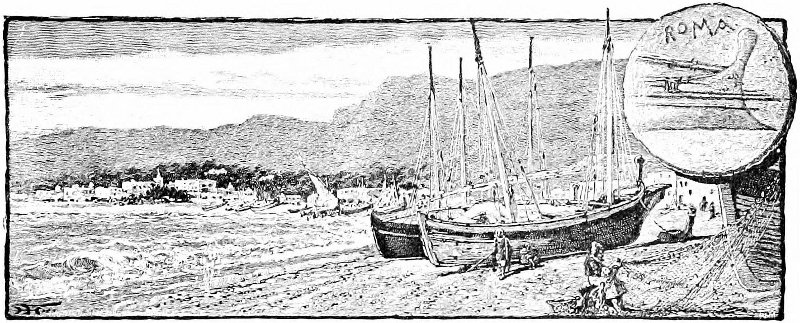
GREEK BOATS AND ROSTRUM OF ROMAN GALLEY.
The first wars of Corcyra were, as was to be expected of an enterprising people, with the mother country; but as in those days piracy was the chief business of every maritime people, war was perhaps only a normal condition. The Persian invasion brought Corcyra into the Hellenic league, but, with the duplicity of which the race furnished so many instances in ancient times, the Corcyriote fleet only sailed, and took good care not to be in time for the battle, fearing the vengeance of the Persians. Their prudence brought on them, after the defeat of Xerxes at Salamis, a combined attack of the Peloponnesian States. As the union of these was always a challenge to Athens, she sided with the Corcyriotes, and the resulting war plunged Corcyra into intestine and social strife, in which the most horrible cruelties were perpetrated by the islanders; and the animosities and renewals of revolt and war, which the divisions of the classes of the population gave opportunity for, reduced the island to anarchy and helplessness. Their subsequent history is one of repeated subjugation and revolt. After losing even the relative independence of alliance with Athens, they were conquered by Agathocles of Syracuse, Pyrrhus, and finally by Rome.
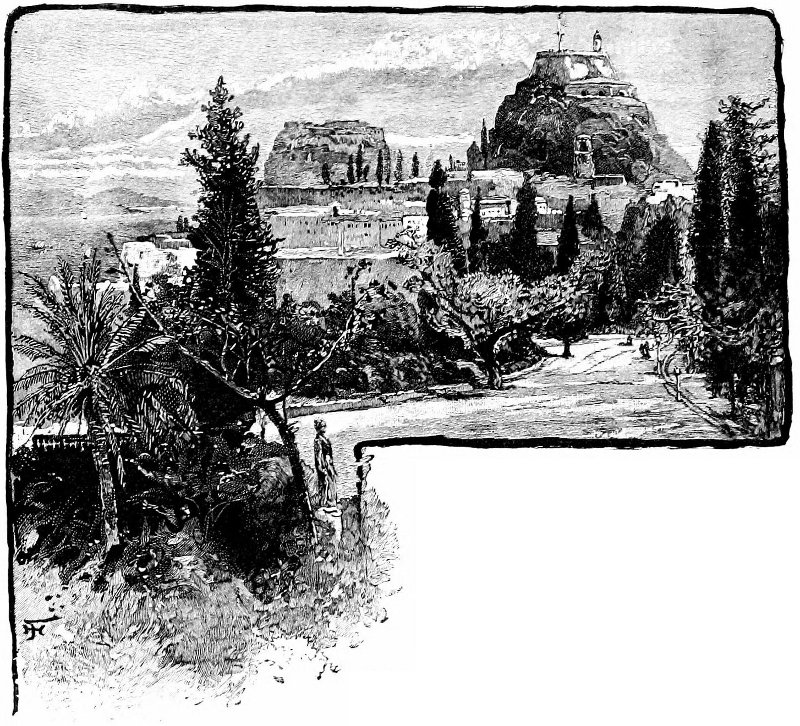
CORFU, FROM THE KING’S GARDEN.
From this time Corcyra was the base of the Roman military movements against the Levantine enemies of the republic. The commanding position of the island has, from that day to this, made it an object of the covetousness of all the maritime powers of the Mediterranean by turns. In the civil wars of Rome, the island espoused the part of Pompey, later of Brutus and Cassius, and then, always unfortunate, of Antony. After the battle of Actium, fought almost within sight of its shores, Corcyra was besieged, taken, and rigorously punished by Augustus, and then relegated to an obscurity out of which only the great Ottoman invasion of Europe brought it. It was involved more or less in the Saracenic, Bulgarian, Norman, and Neapolitan wars and invasions, and finally threw itself into the arms of Venice to save itself from conquest by Genoa. From this time (1386) the history of Corcyra, become Corfu, until the overthrow of the republic by Napoleon, is identified with that of Venice, and all the remains or structures in the island date from the Venetian occupation.
In 1537 the troops of the Sultan, under the orders of the renegade Barbarossa, made a descent on the island and laid siege to the city, which, taken by surprise, was ill-provisioned and with a small garrison. The Turkish fleet blockaded the port, and the troops beleaguered the city by land. The garrison was under the terrible alternative of being starved into surrender speedily or dismissing all the useless mouths. The latter was, on the whole, safer, for the surrender would have been disastrous even to the non-combatants, who were to Turkish barbarity no less obnoxious than the soldiers. The old men, women, and children were sent out of the city, perhaps the most horrible necessity which ever befell brave men. A successful defense of the city justified, in a military point of view, the terrible sacrifice; and, after a long and obstinate siege, Barbarossa, his army nearly destroyed by battle and pestilence, withdrew, defeated. The island was almost depopulated, ravaged, and so utterly impoverished that Venice was obliged to send the people seed-corn and beasts to till their fields. Nearly the whole of the nobility of the island had been killed in the defense.
To be in readiness for a similar emergency, the Senate augmented the already strong fortifications. The New Fort, as it is still called, was constructed, and, with a paternal regard for the well-being of the islanders, which Venice did not always show for her Greek insular possessions, institutions were founded and regulations made which contributed greatly to the prosperity of the island.
In 1716 a new and determined attack was made by the Turks, under the leadership of Achmet III. Their fleet drove off that of Venice, and an army of thirty thousand men was debarked and laid siege to the city, whose defense was directed by Count Schulembourg. The outlying heights were taken quickly, and the garrison, shut in the inner line of fortifications, received the desperate assault of the Turks on the main 16 works with more desperate resistance. After twenty days of incessant attack, the Turks carried the outworks, penetrated to the Place d’Armes, which is under the walls of the New Fort, and attempted to scale the walls themselves.
“The assault lasted more than six hours with an incredible fury. The women brought assistance to the defenders, and the priests, crucifix in hand, ran along the ramparts or threw themselves into the fight. Finally a vigorous sortie terminated this bloody day. Attacked on every side, the assaulting force beat a retreat and lost all the outposts it had taken. A tempest, which had burst on them in the night, completed the work of defeat, and, seized by panic, they embarked precipitately, leaving baggage and artillery behind them. In forty-two days they had lost fifteen thousand men.” (Isles de la Grèce.)
The victory was commemorated by a statue to Schulembourg, which no subsequent conquest has disturbed, and which stands on the parade-ground among monuments of greater or less good taste (generally the latter), to mark the history of the island in modern days.
From that day to this, with the exception of an occasional émeute, nothing has come to disturb the peace of Corfu, and the once so splendid courage of the inhabitants has gone out like a fire without a draught. There is probably no province of the Hellenic kingdom so devoid of martial spirit or the virtues that grow out of it. It is now a most delightful winter resort, a Fortunate Isle left out of the current of political events and given over to invalids and sportsmen, who find on the opposite Albanian coast the best shooting on the Mediterranean. The old citadel, with its double peak, serves as a light-house to the lines of steamers which furrow the Adriatic, cross, and make Corfu their entrepôt between Trieste, Venice, Brindisi, Alexandria, Constantinople, and Smyrna.
The English occupation endowed the island with good roads, 17 most of which are maintained in fair condition still; and a winter’s sojourn here lacks nothing which could be expected in the compass of ten by thirty miles, with two posts per week from Europe. The fruits are those of the northern Mediterranean in great perfection, the oranges being only second to those of Crete; the waters are still well supplied with fish, though the people do all they can to exterminate them by the use of dynamite in fishing; and the Bella Venezia is a hotel which, though still strange to the resources of our American caravansaries, is more appropriate to the ways of the East and of idle people than are ours. The kindly, honest old host, appropriately known as Dionysos, lacks but little of giving to the stranger the hospitality of Alcinoüs. And life is so cheap that one who has worn out the world and realized an income of a thousand dollars a year may find a Macarian peace in an upper room of the Bella Venezia, with windows looking out on the beautiful mountains of Epirus, snow-clad all winter, and the bright blue of the intervening sea, with the coming, going, and merely passing ships of all nations; and, when the sun is low, have a comfortable carriage to thread the labyrinths of the immense olive groves which form almost the only shade in the island. Here one meets men of all races—Turkish reliefs on their way from Stamboul to Durazzo, or Scutari of Albania; white-skirted palikars from Epirus; Eastern Jews, with their characteristic long robes; Persians, Montenegrins, Peloponnesians, etc., who, changing steamers here, or glad to breathe a land air during the stay in port of their steamers, stroll up and down the parade, with the easy-going townsmen and tourists of all nations, seeing the island in comfort or rushing over it in the custody of Cook or Gaze, to carry away a confused remembrance of Corfu and Syra, hardly recalling which was which.
Ulysses was dismissed from Scheria loaded with presents. The modern voyager is not so fortunate. The souvenirs of 18 Corfu which he will carry with him, whether antique or modern, will rarely recompense him for the outlay. The bric-à-brac shops abound in false antiques, arms from Epirus, Greek laces, and Eastern embroideries, which no wise buyer meddles with, dear beyond measure as they are. Be content with the moderate pension of the Bella Venezia, and tempt not Mercury in his favored island; he was the god of thieves as well as merchants, and was never better worshiped in his capacity of joint protector than in the bric-à-brac shops of Corfu.
Ulysses went to Ithaca in one night, in what must have been, for the time, the quickest passage on record, and a great credit to the rowers of King Alcinoüs. Nothing like it is to be expected to-day, though it is not impossible still, and the steamer which does the service makes a long, roundabout voyage. Our yacht, though small, was too big for rowing, and we had no special motive, as Ulysses had, to get quickly to Ithaca. As our route lay by Santa Maura, which has to do with the story of the Odyssey, if not with the wanderings from Troy, we turned aside from his course to visit it. Nericus, as it was called in Homeric nomenclature, probably formed part of the realm of the Ithacan kings, Laertes mentioning his conquest of it; but it is not mentioned in the catalogue, and we may conclude was not Greek. It is barely separated from the mainland by a narrow channel, cut by the Corinthians through a flat, which more anciently, however, must have been a shallow arm of the sea. The action of the elements is filling it up again, so that time may unite it to the Acarnanian shore, as in the Homeric days; for Laertes, in recalling to Ulysses some of his old exploits (Odyssey, book 24), says: “Ah, that it had pleased Zeus, Apollo, Athene, to have borne me to your palace, such as I was when, at the head of the Cephalonians, I took, on the continent, the proud city of Nericus!” In the catalogue of the Iliad we find that “Ulysses commands the magnanimous Cephalonians; the 19 warriors of Ithaca; those of shady Neriton, of Crocyles, of the barren Ægilipos; those of Samos [Samé of Cephalonia, not the island Samos], of Zacynthus [Zante], and of the adjoining continent. Twelve ships whose sides were painted red followed him.” But Nericus occurs nowhere.
Nothing illustrates so strikingly the change in the condition of civilization as the relations between the ancient and modern chief cities of the Greek islands. The substitute for the stately Nericus is a low, flat, uninteresting town, built on the plain which lies north of Nericus, and next the roadstead. To the east lie the rugged mountains of Acarnania and the Gulf of Arta; north, in full view, is the modern fortress of Prevesa; further, and to the east, Arta, the ancient Ambracia; and the long strip of low coast which stretches away from Prevesa northward is dotted with masses of ruin—those of the imperial Nicopolis, monument of the victory of Actium, won in those blue waters. The idle shepherds of those days, watching their sheep on these hills, saw the crash of prows, the flight of Egypt, and the shame of Antony. Perhaps, through this very channel, where the light-draft caïque now glides, to gain the shelter of the islands going southward, ran the fugitive ships of Cleopatra; for this was evidently the channel by which the craft of those days avoided the stormy capes of Cephalonia and the southern point of Nericus. Standing on the eastern brow of the hill on which the old city stood, and on which its ruins still mark a noble past, is the citadel. Along the plain, among the olives, the fragments of tombs lie spread like flocks of sleeping sheep. The port was on the bay now connected with the northern roadstead by the Corinthian Channel; and two or three underground passages, in part cut in solid rock, one being high enough for a man to walk in upright, and cut as cleanly and evenly as the walls of a chamber, connect it with the citadel which dominates the northern part of the island, where the fertile 20 plains lie. The ruins are of various ages, embracing Pelasgic, but mainly later, and coming down to Roman times; and the great extent of the Pelasgic enceinte, which almost everywhere underlies the Hellenic and Roman work, shows the great early importance of the city. The citadel is bold and commanding, and looks out on the northern and western seas on one side, and the Corinthian Channel and the inland sea on the other, and down to Ithaca, which, indeed, is visible from some points.
The post-Homeric name of Nericus was Leucadia. Æneas is represented as having debarked there, and Apollo had a temple on the heights which terminate the island to the south. From the cliffs which overlook the Adriatic on that side, Sappho is said to have leaped into the sea, overcome by the sorrows of her unhappy love. “Sappho’s Leap” is the name of the cliff to this day, and my Corfiote captain, as we glided by, told me how the place was celebrated because the Duchess of the island had jumped off into the sea from it, and that the people had put up a great inscription in memory of it. He had never seen it, and didn’t know exactly where the leap was made; but I think he was very excusable for his ignorance, as the action of the sea, driven as it is sometimes by the furious southwest wind into a very “hell of waters,” which consume the rock in their fury, must long ago have brought down all that classical times had seen of the rock, and changed the face of the cliff entirely. As it now is, I could find hardly a point where a new Sappho would have found a welcome so gentle as the embrace of the Adriatic; masses of fallen rock and stony beach would have given a harsher but more speedy end.
Mythology says that when Adonis was killed, Aphrodite, seeking him through all the earth, finally found him lying dead in the temple of the Erythræan Apollo. The Sun-god, to cure her grief, counseled her to throw herself from the cliffs of Leucadia into the sea, where she would find oblivion. Here 21 Zeus, who seems to have found obstacles in the way of his legitimate marriage, and to have wooed Hera at first with less success than attended his mortal loves, found by the same process a salutary indifference to the charms of his divine sister and afterwards spouse, to which temporary coolness on his part might, perhaps, be ascribed his ultimate success with the fickle fair.
And here, in practical historical times, criminals condemned to death were thrown into the sea. The people (who even now preserve a certain sympathy with the criminal class) used to tie numbers of birds to the limbs of the condemned and cover them with feathers to break the force of their fall, and then send boats to pick them up. If they survived, they were pardoned.
In modern times nothing has occurred to signalize Santa Maura, or “Levkadi,” as it is indifferently called. It was taken and retaken by Turks and Venetians, and finally passed with the rest of the Ionian Islands to the heirs of Venice. Its people are a mild, hospitable race, to whom the stranger is a guest almost in the antique sense.
We loitered along with a feeble west wind, under the western shore, bold and desolate, of Levkadi, its high peaks above us breaking into ravines, and the ravines ending in cliffs, doubled “Sappho’s Leap,” and before us lay Ithaca, the ten-years-sought-for island. To the north was still visible a dim film which we knew to be Corfu; nearer, one less dim, which we recognized by its outline to be Paxos, an island without history and without interest, but which tradition asserts to have been once united to Corfu and separated by an earthquake. The breeze quickened at night-fall as we went round the point of the Leukadian cliffs, and before us lay the inland sea, which, separating Santa Maura, Ithaca, Cephalonia, and Zante from the mainland, is a sort of smooth-water channel for ships coming out of the Gulf of Patras, or of Corinth, as 22 it is indifferently called, or running in there from Corfu and the upper Adriatic. The bolder portions of Ithaca are almost utterly denuded rock. One hollow, like a great theatre, opens northward between two bold rocky peninsulas, and this is the vale from which the Odyssean city drew its prosperity. Olive-trees and vineyards still cover its slopes, and suggestions of white villages flashed out from the silvery green sea of olive orchards as we flitted by, running under the eastern shore to catch the breeze that blew down from the mountain as the sun sank. We had all the wind our cutter could carry, and bowled along through the smooth water in the lee of the island like a steamer. Far ahead we saw, in the gathering night, a faint glimmer of light, which seemed too faint for a light-house, and too steady for a house-light, and which perplexed us exceedingly, as no light was indicated on the chart; but, creeping along shore, we found that it was a tiny chapel standing on a long and menacing peninsula of bare rock, in the window of which burned a lamp,—in all probability the fulfillment of a vow made by some devout Greek sailor who had escaped the teeth of this Scylla; or the perpetuation of an antique custom, when the little chapel of St. Nicholas, protector of sailors, was a temple of Neptune, whom the saint replaces in function and respect of the seafarer. Nothing is more interesting in this part of the world than the evidences of the unbroken continuity of religious tradition, and the gradual change of paganism into Christianity,—if, indeed, the change has taken place, which in certain districts I am scarcely disposed to admit. The little chapels which one finds planted by the seaside or solitary roadside in all the Greek islands, and even on the mainland, will generally be found to have some antique material in them, some evidence of the earlier shrine which honored one of the Greek gods. The Olympians have their homologues if not their homonyms. Zeus goes back to his awful antique dignity of the All-father, the original sole deity 23 of the Pelasgian, worshiped in a temple not made by hands, under the speaking oak of Dodona, the one God, maker of heaven and earth, the Dyaus or Sky-father of our Aryan ancestors, and Zeus (Deus, Divus) of the western branch of the family; but his creatures and children fall into the lower rank of saints: Apollo becomes St. Elias (Helios); Athena, the Virgin Mary; Ares, St. George; Poseidon, St. Nicholas, etc., etc.
We left St. Nicholas and his night-light behind us, and, rounding a cape into the Bay of Vathy, saw in the dim distance the light of the outer light-house, and met the wind coming out of the bay. It was late, and beating up the bay would be a long job; so we turned in and left the navigation to the sailors. The next morning we woke, as Ulysses did, under the shadow of Neriton, where the Phæacians had left him sleeping.
“In one part of Ithaca is the port of Phorcys, the old man of the sea; the bold promontories forming the circuit protect it from the great waves and the sounding winds. The ships which have once entered it may lie without cables. At its extremity is a bushy olive-tree whose shadow hides a delicious grotto and shady retreat, sacred to the Nereids. In this asylum, refreshed by an inexhaustible fountain, are placed the vases and the jars of stone.... It has two entrances: one, looking toward the north, is for the use of men; the other, to the east, is more divine. Never man enters there: it is the path of the immortals.
“The olive-tree and the grotto are known to the Phæacians. There they go. The ship runs half-way up the beach, so strong is the stroke of the rowers. Then these land, carrying Ulysses, still plunged in profound sleep, and lay him on the sand, wrapped in brilliant blankets and woven linen.”
Waking, he is bewildered by the artifice of Athena, and does not recognize his native island; but finally, when he 24 appeals to the Goddess to tell him the truth, if he be in Ithaca, she replies to him:—
“Now I will show you the localities of Ithaca, that you may doubt no more. There is the port of Phorcys, old man of the sea; there, at the extremity of the port, the bushy olive-tree, and under its shade a delicious grotto, dark resting-place, and sacred to the nymphs. This is the vaulted grotto where often you sacrificed entire hecatombs to the nymphs. There is Mount Neriton, shadowed by forests.”
The identification of this little bay or “port” is the one contested point of the topography, and, on account of its greater commodiousness, Port Vathy (at the left as we enter the roadstead) is maintained by some authorities to be the “port of Phorcys.” The geology of the two bays is conclusive evidence in favor of that which the Greeks now call Port Dexia (the right-hand port), as Port Vathy has not, and by its geological formation never could have had, a beach such as Homer describes, and which was indispensable to the ancient sailor, while that of Dexia is superb—a soft, unbroken stretch of sand. Other objections we shall meet further on.
[Note.—The puzzling question of the forms of classical names in these articles has been carefully considered, and the difficulty of adapting consistent classical orthography to popular archæology seems too great to be overcome in this place.]
The changes of the conditions of existence in what we call civilization resemble, a good deal more than we generally imagine, the progress of a horse in a tread-mill. Comparing the evidences of a higher prosperity which history affords with what we now find in Ithaca, we have ample ground to suppose that, while our part of the world has made certain advances, this has rather retrograded. A scanty population, the greater part of the island indeed uninhabited; ruins of great cities where now there is not a shepherd’s hut; a wretched, sordid life in which not even poetry, the offspring of sorrow, can find a foothold; utter insignificance in the world of men,—this is what the island of Ulysses, which fills so large a part of the Old World’s poetry, shows us to-day.
We woke like Ulysses under the shadow of Neriton, but not like him under the olive’s shade. Our yacht was anchored in a tranquil and land-locked bay, Port Vathy (the deep), round the shores of which stretch and gleam, white in the sun, the houses of the modern capital of Ithaca, a dull, utterly uninteresting town, neither whose past nor present is worth a note.
Devastated by Turks and corsairs by turns, conquered by Christian and Infidel, the tribute of death and pillage had at one time nearly left the island a desert, and Venetian chronicles report the repeopling of it by a Slavonic colony; but there is good evidence, as we shall see presently, that there was never quite an end of the original stock. Though one does see occasionally strongly Slavonic faces, the population is now in language and manners purely Greek, with some of the worst traits of the race strongly developed. By good chance I 26 found an old acquaintance in Mr. Caravia, a deputy for Ithaca to the Greek Assembly, then in vacation, and I had a letter to Aristides Dendrinos, the principal personage of the island; and through their united attentions we were made as much at home in Ithaca as possible. But the Ithacans are shrewd folk, sharp dealers who look at foreigners as the Hebrews did on the Egyptians, as made to be spoiled; and we were unlucky enough to have arrived in the Greek Lent, which, as they observe it, is equal to starvation to outsiders. The excellent wine of Ithaca, one of the best of Greek wines, is quite worthy its ancient reputation; but flesh was unattainable, and fish so rare, owing to the people’s habit of killing them with dynamite, that we could not get enough for a breakfast. The fowls in Greek lands, living an outcast life, never fed, but expected to grow, as the partridges do, on the bounties of nature, hardly offer a compensation for the trouble of picking their bones. They combine all the misfortunes of the wild and domesticated conditions, with none of the advantages of either, and offer a scant resource to the caterer. We made haste to see what was to be seen in Ithaca, and study our great predecessor’s footprints, but we found the learning harder than the living. The island Greek is quick-witted, and, like the Irishman, never confesses himself at fault in anything you want to know, especially in things connected with ancient history or archæology. He solves the hardest and most obscure problem by a bold dash, and is even surer than Schliemann in his breezy inductions. It is amusing and cheering to see a man so cock-sure of what archæology has puzzled over so many years. On inquiring for a guide to shorten my researches (for, though Homer is guide-book enough for Ithaca, one may be a long time in tracing out the Odyssean movements by the poem), every one was ready to show me everything. Before leaving I found an intelligent guide, as such go, in one Angelo Persego, whose name I 27 record for the benefit of such of my readers as may be tempted (out of the Greek Lent) to visit Ithaca. But here let me drop a word of advice for all voyagers in Greek lands. Take a guide for lodgings and living, but never place any confidence in his identifications or local traditions. He may be right, but the chances are nine to one he is not. He may even have been over the ground before, but his assurance to that effect is no evidence. I found the men I selected utterly ignorant, as usual, of almost all I wanted to learn; but I found a little book by G. F. Bowen, one time Fellow of Brasenose and President of the Ionian University, which, though dated in 1850, gives a sufficient clue to the topography to enable one to dispense with a guide, except to find the best roads.
Vathy does not occur in the Odyssey under any name, nor is there any trace of antique structures about it. In the illustration the narrow entrance at the right is Vathy; the cove in the centre, with the island off it, is the port of Phorcys, where Ulysses was landed, and which, for the uses of ancient mariners, who beached their ships instead of anchoring them, was a better port than Vathy. It corresponds in the minutest detail to Homer’s account of it,—a smooth, sandy beach, complete shelter from all winds, and only varying in any particulars in its surroundings by a greater distance from the grotto where the Phæacians hide the presents Ulysses brings with him; but of this more is to be said.
The Odyssey gives no intimation of any city near the landing-place. The port of Ulysses’ own capital was much nearer Phæacia, and the ship might have landed him at his own door. The reason of this excessive caution was that during so long a time he had had no news from home, and his Phæacian friends knew that he might find his city in the hands of an enemy.
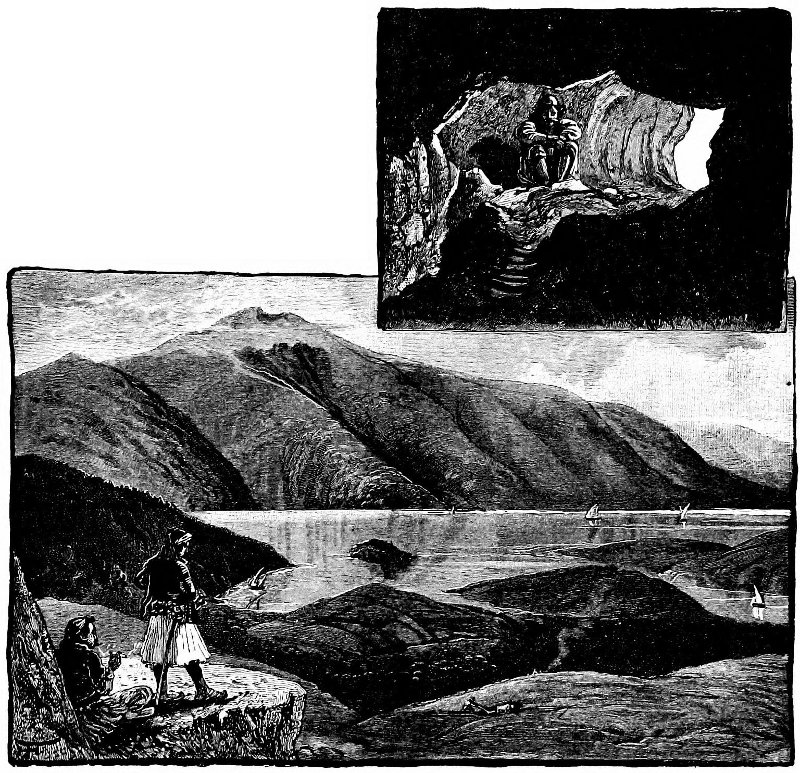
PORT OF PHORCYS AND NERITON, FROM THE MOUTH OF ULYSSES’ CAVE.
Awaking, then, from the sleep in which he had been so gently landed by the crew of the Phæacian ship, he finds himself in a strange land, as he supposed, and in complete solitude, and arms himself with his habitual cunning, distrusting everything. When Athena comes to him in the form of a shepherd, he asks where he is; and being told that he is at last in the long-sought Ithaca, he is transported with joy, but conceals his emotion and addresses the goddess with these hasty words, disguising the truth and telling his story falsely, always turning in his mind many artifices: “I, too, have heard, in the far-off, immense island of Crete, of the island of Ithaca. It is, then, in that country that I have arrived with my treasures. I have left an equal part to my children because I fly from my native land, where I killed the dear son of Idomeneus,” etc., etc., going on with a long history to account for his presence in Ithaca, a place unknown to him, which fable he only drops when Athena 29 throws off her disguise; but he still is unconvinced that he is in Ithaca. She calls his attention to Neriton in front of him, and having convinced him, helps him hide his treasures in the grotto, when they sit down under the olive-tree over its entrance, and she tells him how matters stand at home, and contrives plans for getting rid of the pretendants, who would, no doubt, put an end to him if he fell into their hands. This seems to be his conviction, for he exclaims: “Great gods! if you had not enlightened me I should have perished in my palace, like Agamemnon. Come, let us plan a means by which I may revenge myself on them all.” This hint of the fate of Agamemnon, whose end he had learned, is the clue to his cautious deportment. They plan as follows: He will be disguised by Athena, so that not even his wife shall know him, and will then go to Eunæus, who keeps his swine by the Raven’s Cliff, near Arethusa’s fountain, and wait with him studying up the position, while she goes off to Lacedæmon to bring back Telemachus, whom she had sent there nominally to get news of his father, but really, as she informs Ulysses, to give him an opportunity, hitherto wanting, to see the world and acquire renown. Here they separate, and Ulysses takes the secret path.
The position of the grotto makes the only difficulty in tracing all his movements; for it is not, as one would expect from the text, at the head of the port, strictly speaking, but at the head of the little ravine which ends in the port, a good quarter of an hour’s walk from the shore, even making allowance for all the recession of the water-line, which has evidently been considerable. The grotto itself corresponds exactly with the description, and can be entered by mortals only in the usual way, by the small opening which looks toward the port. “It has two entrances: one, turned toward the breath of Boreas, is for human use; the other, toward that of Notos, is more divine. Never man enters by that; it is the way of the 30 immortals.” The human entrance is a low, almost invisible opening, or at least, easily passed without notice, at a short distance. Even now, when all vegetation has disappeared from around it, and the olive-trees come only half-way up the hill, it would easily be hidden by a large stone, as Minerva hides it. The entrance, low and precipitous, widens rapidly within, and we descend by what might once have been artificially prepared steps to a vault-like cave, sixteen to twenty feet in diameter, with a curious recess at the farther end, and at the top of the vault another opening, like the top window of the Pantheon of Rome, or any of the circular temples whose form was derived from the vaulted tomb or treasury of Pelasgic architecture. At first sight I thought this opening might have been artificial, but on close examination I saw that the formation of the rock led to it naturally, and that, hardly large enough to admit a human body readily, it could only, if enlarged, be entered by a person’s being let down with a cord. This is the “immortals’ entrance.” Under this opening lies a huge heap of stones, the accumulation of centuries, for the lower portions are cemented together by the stalagmitic deposit from the rock above; and the walls of the grotto, despite the breaking off of every attackable stalactite, are also formed of carbonate of lime so deposited. The difference between the actual distance from the water’s edge to the grotto and that which is indicated by the narrative of the Odyssey is not more than a fair poetic license would permit; or the memory of the narrator, having known the localities, might well in a few years of absence leave out this short distance.
The Odyssean topography is greatly confused to the modern traveler by the fact that the Homeric city undoubtedly stood at the northern end of the island, and far remote from the modern city as well as from the landing-place of Ulysses and the pig-pens of Eumæus. The view from the grotto gives us, at the left, a bay of which Vathy and Phorcys are tributaries. 31 This cuts the island nearly in two, a narrow ridge of rock only connecting its two great masses. On the north is the site of the Homeric city, as I shall presently show; but on the south are the Raven’s Cliff and the fountain of Arethusa, together with an ancient ruin known by the people as the “Castle of Ulysses.” These ruins are of the earliest form of Pelasgic, commonly named Cyclopean, though there is no justification for any distinction between the “Pelasgic” and the “Cyclopean,” or any proper distinction of styles, as they run into each other, from the form shown at “Ulysses’ Castle” to the most elaborate and carefully fitted polygonal which we shall find at Samé on the opposite shore of Cephalonia. The walls of Ulysses’ Castle are of great extent, and portions still remaining near the summit are well preserved, some fragments being nearly twenty feet high. It must have been the work of a powerful tribe and a great stronghold. Seen from the sea, it shows on a sharp conical rock precipitously trending down to the shore. The Odyssey in no manner makes allusion to this, either as city or as ruin. Ulysses passes very near it going south, leaving it on the right, apparently ignoring its existence. This makes it tolerably clear that it had been so long in ruin that it was in no way to be connected with the Odyssean dynasty or colonization even, or that it was constructed after the Homeric epoch. The latter hypothesis is untenable, because we find in many parts, especially in the Argolid, ruins clearly contemporary with this, which are in the Hellenic traditions regarded as the work of a vanished and semi-divine race of giants, the Cyclopes or the “divine Pelasgi;” while, of the Homeric epoch, as distinguished from the Pelasgic, which preceded it, and the Hellenic, which followed it, we have no recognizable remains, and the cities known to have existed, such as the Ithaca of Ulysses, have left no ruin durable enough to show in our time. This indicates a state of civilization in which the great necessity of strong 32 walls as a defense had passed, or that, by the use of cement, walls were made so light in structure that they were efficient for the day, but perished utterly in the intervening time, which again is an untenable hypothesis, because we find cement used nowhere in Greece in work known to be earlier than the third century B. C. I leave the question of the identity of the Odyssean epoch with that of the composition of the poem at present untouched. I am dealing only with the poem which philologists suppose to have been composed about 850 B. C. That the author knew Ithaca perfectly, I think we shall see, and that consequently the ruins of the Pelasgic epoch, when not continuously inhabited (as were Nericus and Samé, the former of which Laertes conquered, and the latter of which sent the largest deputation of “kings” as suitors for Penelope, the foundations of both being Pelasgic), were already so lost in the twilight of prehistory as to be without any meaning to the author of the Odyssey. The city whose ruins are now called the Castle of Ulysses was as unknown to the epoch of Homer as to ours. No one in the whole action of the Odyssey goes in or out of its gates, or turns aside from his path to speak of or visit it. “Kings” were as common as rascals in those days, but that two important cities should exist contemporaneously in the small island of Ithaca, and that the people of Ulysses should live in one, pasture their hogs on the territory of the other, and ignore its existence, is impossible. This does not prevent Schliemann from identifying the house walls, which remain to a small height, with the pig-pens of Eumæus, or a huge stump near the citadel, with the tree from which Ulysses had made his bed (Ithaca, Peloponnesus and Troy).
That this part of the island was nearly or quite unpopulated is made more than probable by the facts that no mention is made of any city or people here; that the only features mentioned are the wildness, and forests abandoned to feeding 33 of pigs; and that Ulysses selects this part for his concealment. The path Ulysses probably followed from the port of Phorcys to the Raven’s Cliff is by far too hard for dilettante following; it is not only impassable to beasts of burden, but, I should say, difficult for a pedestrian. There is a road carriageable for a few miles from Vathy along the ridge southward, and then a fair bridle-path to the cliff, which, had we known it, would have led us somewhere near the location of Eumæus’s sties; but the guide my friends had recommended me, on his personal assurance, did not know the road, and we went wandering across fields and over hills, abandoning our quadrupeds at the moment when they would have been our best guides; and, finally, the fellow had to go to a ploughman scratching the earth with a crooked stick behind a yoke of year-old heifers, and inquire his way. I exhausted my modern Greek in exasperated vituperation of his pretentious ignorance, and took the lead, as I generally have had to do on similar occasions.
There was a pretty little valley on our way, the only arable or fruitful land in this part of the island; all else was bare and bleak. A few tough-lived shrubs, broom and gorse, arbutus, and some others I did not know, wring a scanty subsistence from the clefts between the rocks, and in a mass of almost unmitigated limestone was cloven a ravine. The roughness of Ithaca was proverbial even in Homeric days, since Athena, while disguised as a shepherd, replies to Ulysses, “If it [Ithaca] is rocky, if it breeds not horses in its moderate space, it is not quite barren,” etc. One might well select this scene as one of tranquil beauty, with the faint glimpses of the dreamy inner sea above its valley distance, and the golden grain-fields as I saw them, interspersed with vineyards and olive-orchards.
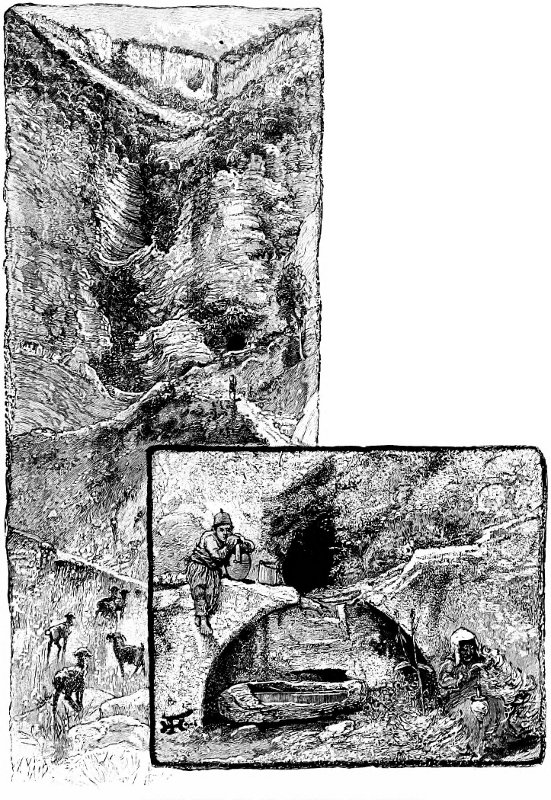
RAVEN’S CLIFF AND THE FOUNTAIN OF ARETHUSA.
The glen of the Raven’s Cliff becomes a wild gorge below the fountain of Arethusa, and descends abruptly to the sea. Above, a stripe of bare, pale-gray rock down the cliff shows that in winter it is the location of a cataract, though, when I visited the locality, dry as summer dust. The fountain of Arethusa is situated about half-way from the cliff to the sea, and bears the evidences of an immense antiquity. Remains of an architectural surrounding are still to be seen, which, with some foundations of walls of the Roman period, evidently of a temple to the nymph or local goddess, and “Ulysses’ Castle,” are the only traces of ruin discoverable in this lobe of the island. The recess of the fountain has once been much larger, but 35 the slow process of depositing the calcareous incrustation which forms its walls has gone on so long that only a small deep basin remains, from which the people draw the water with a cord and bucket. Its niche is cushioned with moss and maidenhair ferns, and the soft porous rock is always moist with the filtering through of the water. A wooden trough is placed for the watering of the sheep and goats which take the place of the hogs of Eumæus, for this is the only perennial source of water in the region.
An old woman, wrinkled and bowed, looking like one of the Fates, sat near the fountain, combing the wool she had washed at it; and on the opposite side the nymph of the fountain, in the shape of a young matron of some neighboring hamlet, was washing her clothes. The wash was boiling when we came up, over a fire of brambles and weeds; but the utensil which took the place of the bronze caldron of the antique house-mother was an American petroleum-can, with a wire bale fitted in rudely, and the stamp of the New York Refining Company was still visible on the tin. We talk of the omnipresence of gold, of the omnipotence of cotton; but in my wanderings on the earth I have found places where the people did not know the value of a piece of gold, and wore nothing but the homespun and woven wool of their flocks and flax of their fields, while I have never found one that did not know petroleum; and I have learned that the petroleum-can is a more universal concomitant of civilization than English cutlery or American drillings.
The pens of Ulysses’ pig-herd were at the top of the cliff, where a plain of small extent and soil of scanty depth still maintains an olive-grove, sole representative of the forest of oaks whose acorns fattened the swine for the revels of the suitors of Penelope.
Here Ulysses finds Eumæus, and here, in his anxiety to convince him of the truth of his prediction of the return of 36 the wanderer, he says: “If he return not as I declare, let your servants seize me and throw me over the high rock, that vagabonds may learn in future to abstain from useless falsehoods.”
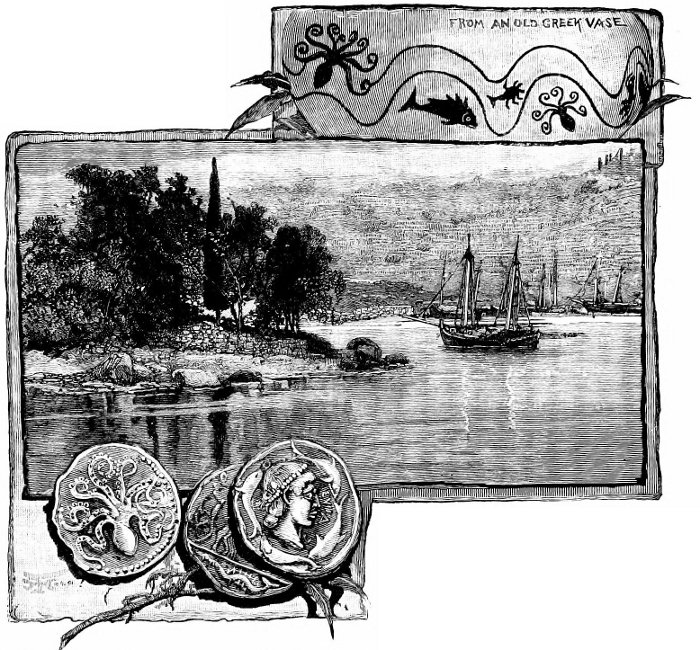
FROM AN OLD GREEK VASE.
THE SITE OF ITHACA—PORT POLIS.
To return to the city of Ithaca, Ulysses must retrace his steps past the port of Phorcys, and follow the ridge of rock which connects the divisions of the island past the mass of Neriton. His landing-place was on the east side of the island, the port of the ancient city Ithaca on the west; and there are now on the road between, several villages, the representatives, perhaps, of the ancient towns from which Ulysses drew his quota of men for the Trojan campaign, “Crocyles and the rocky Ægilipos.” It was in one of these villages that Schliemann, visiting the island for the first time, in his Homeric enthusiasm, as the villagers, in their habitual curiosity to see the stranger, came out to gaze and question, taking the assemblage as a demonstration 37 in his honor, and determined to show them how well he estimated the dignity of an heir of the Odyssean glory, mounted on a table and translated from Homer the passages which record Laertes’ emotions on the return of his long-lost son. “They wept with emotion,” says the naïf Doctor; and he rewarded them by some hundred lines more. Remembering this incident, I inquired about the matter, and found that it had excited much merriment in the cultivated circles of Vathy, and, as I expected, the other side in the rencontre preserved a very different recollection of the Doctor’s achievement, and that the tears were of merriment rather than of pathos. No one in the assemblage could understand a word of the Greek in the Doctor’s pronunciation of it.
In the nomenclature of the two principal higher villages of the northern section, I found a curious survival of archaic language, which, so far as I could learn, is as incomprehensible as Homer, in the original, to the inhabitants. The villages are Anoï and Exoï, which are clearly from the archaic and (except in the Cretan mountains) obsolete words ano and exo, used as haw and gee are by us in driving oxen, and of course meaning originally right and left, and these indicate site survivals of early towns or villages. But of Ithaca the city, the home of Ulysses, not a trace remains except the name Polis (city, the city par excellence), which is applied to a locality where not even an ancient wall shows a claim to the appellation. The fragments of substructure shown on the hill above and near the village of Stavros are undoubtedly mediæval, and belong to the piratical city which was established here, and which was destroyed in the latter part of the sixteenth century. I searched in vain for anything to indicate the date of the ancient city, but here, doubtless, was the home of Ulysses. Its little port is of the nature demanded by ancient mariners,—a smooth beach in a cove, with the island of Cephalonia opposite and near enough to shut off any great violence of sea 38 or wind. Homer relates that the suitors, when Telemachus had gone to Pylos to get news of his father, sent out a ship with some of their number to intercept and kill him on his return, and that this ship lay in watch at an island off the port where the return of Telemachus’s ship could be seen from afar and prevented. Opposite Port Polis is a rock, probably the remnant of that island; for, as the material of it is a conglomerate easily subdued by the elements and decomposing rapidly, it must have been once a considerable island, and it is now the only remnant of rock or island which occupies any such relative position.
In searching around the neighborhood for traces of antiquity I was accosted by a peasant, who told me that there had been found a stone with some letters on it, and I made haste to hunt it out. They (for there were two fragments) were at the bottom of a heap of stone which had been exhumed from under a land-fall, and which were evidently part of a very ancient building. I hired the men who gathered round to remove the heap, and photographed the stones, which had been originally one. The inscription is in the early style of Greek epigraphy, boustrophedon, i. e., going alternately from left to right and right to left, as oxen go when ploughing. It is the oldest known inscription in the Ithacan alphabet.
I placed a copy of the photograph in the hands of Professor Comparetti of Florence, amongst others, and received from him the following, read at a meeting of the Academy of the Lincei:—
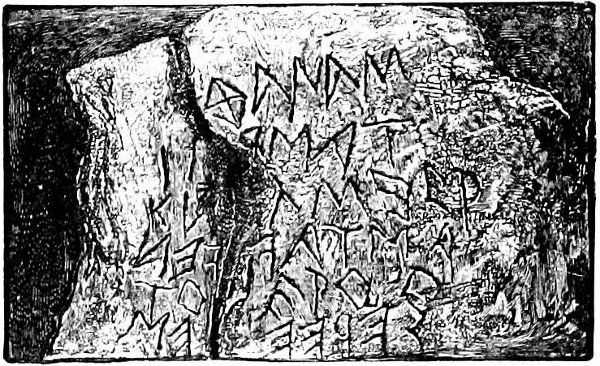
INSCRIPTION FOUND AT POLIS.
“Since I have hitherto spoken of inscriptions very old or archaic, as we say, it will be permitted me to close this communication by presenting to the Academy a curious inscription of this kind recently discovered in Ithaca and communicated to me by a diligent and cultivated visitor to the Greek lands, the American, Mr. Stillman, who made in Ithaca a photograph of the inscription, and, having unsuccessfully asked an interpretation of several scholars, applied to me. He has permitted me to make communication to this Academy, putting at my disposition also the negative of his photograph, from which are printed the copies I present. The inscription is tolerably roughly cut in a friable stone, broken in two, worn by time and water. The photograph, which is never the best means of representing monuments of this kind even in experienced hands, presents some confusion and obscurity in parts; but this is the only difficulty in the epigraph.... I saw at once that this was an inscription of which there was already some notice in a book published by the Phœnix of discoverers of antiquities, Schliemann, in 1868, ‘Ithaca, Peloponnesos, and Troy.’ Rich as he is in fancy, Schliemann is ready to believe any story, and at once convinced himself that he had discovered the inscription of a very old sarcophagus, and found an honest workman who helped him to complete the idea, showing him the bones found in it by him. And in his book, together with this and other news, he communicated the inscription such as he read it. Of the two fragments, however, he only saw that at the right, and this he read very badly, seeing letters where none are, and imagining incredible forms of letters. Kirchhoff in his ‘Studien zur Geschichte des Griechischen Alphabets’ sought to apply this monument to his purposes, but could make nothing of it, and it would have been impossible to get anything from it. Now, thanks to the intelligent care of Mr. Stillman, we have before us the monument as it is; he knew nothing of Schliemann; when he saw the inscription, he saw that it was incomplete, and seeking amongst the stones, found the other piece, and, divining justly its relation, united them and took the photograph 40 which now permits us to utilize what we may call his discovery.
“The epigraph is certainly very old, besides being boustrophedon. This is shown particularly by the forms of the sigma and iota. It was cut roughly and by hands little used to such work, without any care for symmetry in the disposition of the letters or of the lines, nor for the uniformity of the letters. Some letters are lost in the fracture, others by the wearing of the stone, and the entire inscription is mutilated in the lower part.
“The reading, with the filling up, is as follows:—
τᾶς [Ἀ]θάνας
τᾶς (Ρ)[έ](ας)
χα[ὶ τ](ᾶ)ς Ἡρ
ας τα (ἔ) [ν]τεα
τῶ[ἱ]ερῶ οἱ
ἱε[ρ]εε[ς] (Κες-
π
“Translation: ‘Of Athena—of Rhea—and of Hera—the sacred utensils of the temple—the priests, Kes—placed.’
“Probably the names of the three priests followed, the first commencing with the letters Kes,—perhaps Kesiphron,—and there ought to follow τάδ’ ἒνεθεν or τάδε χάτεθεν, or similar expression. The inscription, then, has nothing to do with a sarcophagus, or with the dead. It treats, on the contrary, of a hidden treasure, that is to say, of the sacred utensils of a temple in which were worshiped the three divinities, Athena, Rhea, and Hera, each one having her peculiar priest. It is well known that there is nothing new in this case of three divinities worshiped in the same temple. We know that Athena was especially reverenced in Ithaca, and are not surprised to find her first in the list. Then to explain this inscription, it may be supposed that in some perilous time of war, revolution, or other danger, these priests decided to put 41 in security the treasures of the temple and hid them in a safe and secret place, leaving there this inscription, so that in any case the nature and origin of the objects might be known. Probably they cut the inscription themselves that no one else might be in the secret, and this would explain the signs of haste and inexperience in the cutting, while on the other hand the language, like the orthography, is correct.”
The attribution to a sarcophagus by Schliemann is difficult to explain as a mistake. If it had been, as he says, on a sarcophagus that he found the right half of the inscription, he must have found the whole; but the fact is that there was in the whole pile of stones no fragment of anything like a sarcophagus, an object unknown in Greece till centuries later. The inscription had evidently been a mural tablet and was about eighteen inches deep and of a shape and size which made it impossible to take it for a fragment of a sarcophagus; and underneath the mass of debris from which it was extracted the workmen found a pit, which was excavated, they told me, without finding anything; nor, they said, was any object of antiquity found with the stones, while Schliemann engraves a lance head and a coin of about 300 B. C. which he says were found in the sarcophagus. This proves nothing, for when anything is found the absurd rigor of the Greek laws makes the concealment of it the first object of the finder. If this pit, when discovered, had still contained the sacred objects, what a find if archæology could have profited by it! But as the Greek law in case of concealment would have punished the excavator by confiscation, or in the best case by taking the half of the objects found, the first precaution taken by the finder would have been to remove, if possible, to a foreign shore, and if not, to melt down, if of precious metal, the objects found. Until Greek legislation on archæological research is more intelligent, it will be gravely handicapped. The greater part of the value of an object is often to know 42 where it came from, and this we never know of objects found in Greece by chance or private excavation. There was some years ago a report, which had certainly considerable confirmation, of the discovery of a great treasure in this very part of Ithaca; possibly it may have been this. If we could have found the vessels of the temple, they would have given us the art of the descendants of the Dorians in Ithaca at least six hundred years B. C.; for this inscription is Doric, and dates from about that time.
In any case, we may be confident that our inscription marks the site as having been in the vicinity of a city of, or little later than, the Homeric epoch, as, supposing the Odyssey to have been composed in 850 B. C., only about two hundred and fifty years could have intervened between its composition and the placing of this inscription; and we know of no ethnic revolution which would have destroyed the Homeric city between the Dorian invasion and the wars of Corinth.
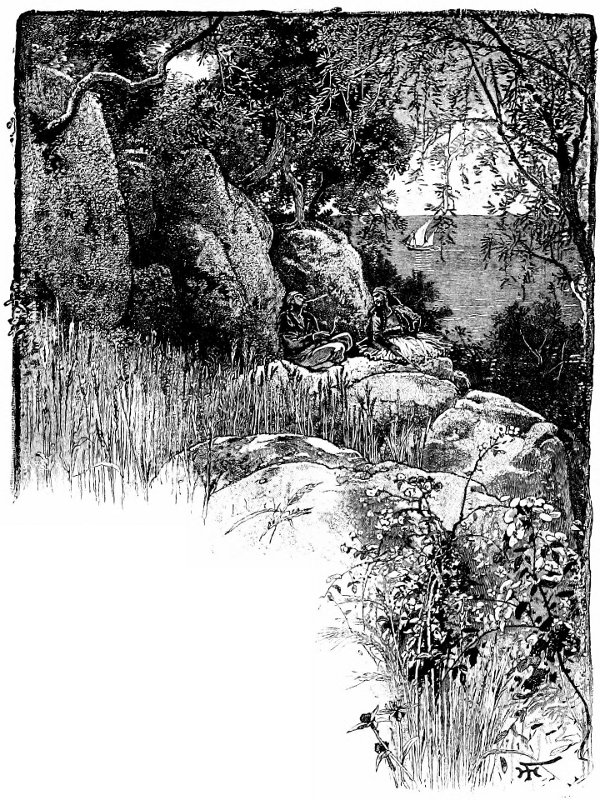
THE SCHOOL OF HOMER.
But if there are no traces of the Homeric city, and none of earlier construction in the immediate neighborhood of the site, there is in the interior of the island, and in the northern lobe, which we see was probably the special domain of the Ithaca of Ulysses, a most interesting antiquity which is now known as the “school of Homer.” It is in all probability a sacred place of the Pelasgic epoch, as on the rock above it is a chapel whose substructions are clearly Pelasgic and most probably the remains of a Pelasgic temple, which alone would account for its preservation, and is probably also the reason of its conversion into a Christian church. It is on a scale in keeping with all the remains we have of the heroic epoch, about twelve by twenty feet, and though much repaired in the modern adaptation, still shows its ancient dimensions and style of building in the lower courses, too solid to have been rearranged, though some of the upper stones have evidently been replaced in later times. It stands on the brow of a low 43 bluff, below the village of Exoï and not far from the “field of Laertes,” which tradition points out at a little hamlet below. Traces of other walls extend to the brink of the precipice that overhangs the “school,” and round by the side is an antique flight of steps, mostly preserved and cut in the solid rock, that served as passage between the temple and the “school,” which may have been the place of sacrifice or possibly an area for the holding of the council. It is mainly cut in the rock at the foot of the precipice on which the temple was built, with a double flight of steps, also cut in the rock, descending to the ground below. 44 It is not above fifteen feet across at its widest, and the decomposition of the solid rock by time and weather leaves only the general shape and character, with some of the steps above and below it, still tolerably perfect. It was a lovely place, and if the shade now thrown by the olive-trees which surround it was anciently given by plane-trees, it would have been still more striking. You look off on the sea and the distant island of Levkadi with the mountains of Acarnania, and through the interstices of the olive-trees you catch glimpses of the cultivated valley beneath, where, if anywhere in this end of the island, old Laertes must have had his field, as here only is tillage possible. North is the sea, south the huge wall of Neriton, east the rugged mountain that looks out on the inner sea, and west that on which Exoï is raised to the clouds and from which one looks down on the Cephalonian channel at its foot. Like the plain or valley between the Raven’s Cliff and Vathy for the southern lobe, this is the only valley for the northern. The “school” is poised thus midway between the valley and the mountain peak; and whether, as the islanders pretend, it was the place where Homer read his poems, the council place of the ancient heroes and kings, or the hieron of Pelasgic priests whence the smoke of sacrifice went up to the great Zeus, the choice of locality was one which suited alike its uses. The young wheat was springing into head in all the interspaces of the close-standing olive-trees, and the rocks above were overhung and draped with wild sage and gemmed with wild flowers. The boy who guided us assured us that there was a secret passage to the top of the rock, filled up now; and a peasant passing by stopped to see what we might be saying or doing, and finding that our interest was fixed on palaia pragmata, offered to guide us to an ancient rock-cut well in the valley below. We found the door which opens to the passage, which led down a stone-cut staircase to the well, far in the ground; but as the well belonged to the priest, 45 who had the key in his pocket, and was, no one knew where, we had to be content with the door, which was modern enough, though fitting an opening cut in the rock very evidently ancient.
In this vicinity must, by the force of nature, have been the residence of all the agricultural part of the population of the ancient Ithaca. Says the poem:—
“Ulysses and his companions withdrew from the city and soon arrived at the magnificent garden of Laertes, which the hero had formerly purchased with his wealth after the many ills he had suffered. There stands his dwelling, surrounded on all sides by a portico where the slaves who cultivate his estate sleep and eat. In the porter’s lodge is an old Sicilian,[6] who in this solitary place, far from the city, takes care of the noble old man.... At these words he gives his arms to the herdsmen who enter into the house of their master, while Ulysses, to find Laertes, enters into the garden. The hero goes down into the great vineyard and finds neither Dolias nor his sons, nor the other slaves. Dolias has led them far away to gather thorns to make hedges round the inclosure. Ulysses finds his father digging round the root of a tree in the garden. Laertes is dressed in a dirty patched tunic; around his legs he has bound, to preserve them, greaves of sewn leather; gloves protect his hands, and his head is covered by a cap of goat-skin, which completes his mournful appearance....
“‘Ah,’ replied Laertes, ‘if you are Ulysses, if you are my son returned to this island, describe to me a sure sign that I cannot mistake.’
“‘See first,’ replies Ulysses, ‘this wound, which long ago on Parnassus a wild boar gave me with his tusk, when I went 46 to Autolycus to bring the presents which he here had promised me. Then listen, I will describe to you the trees of your beautiful garden which you gave me, and I asked of you in my childhood as I ran behind you. We passed through your inclosure; you told me the name of every tree, and you gave me thirteen pear-trees, ten apple-trees, forty fig-trees, and then you promised to give me fifty rows of vines in full bearing.’”
The legends of the modern population of Ithaca must not be confounded with real local tradition, transmitted from ancient times. They are unquestionably the reflection of literary statement, the reiterated conclusions of students more or less well informed as to the true archæological bases of opinion. The attribution of the particular spot we visited as the garden of Laertes is doubtless due to reading of the Odyssey, and, like the location of the “Castle of Ulysses” on Aëtos, arose from a popular rendering of the story as handed down by literature and converted into legend, which is located wherever the crude antiquarianism of the people judges best. An instance of the real tradition which has a distinct value in archæological research is that of the preservation of the name Polis for the abandoned site where unquestionably the Homeric city stood; and this simple indication is sufficient to prove that Ithaca was never entirely depopulated and repeopled by Slavs, because in this case the continuity of tradition would have been lost, and there is no ruin to restore it in modern times, even if it were capable of surviving the interruption. If it had simply been handed down by a Slavonic colony, it would have been “Arad” instead of “Polis,” while, if the depopulation had once been complete, names which are not now understood by the present inhabitants could not have originated with them. If the name had sprung from the presence of ruins, the site on Aëtos would have received it instead of its present legendary appellation, so 47 that in no way can we explain the survival of the name Polis for the site, or the names Anoï and Exoï, except by supposing them to have clung to the places from Homeric times through a continuous population of Hellenic stock, however thinned. Another curious incident illustrates the tenacity of this kind of survival. As we were passing through one of the villages, I heard one child calling to others to run to see the barbarians, οἱ βάρβαροι (várvari), just as the Greek children of ancient times would have called us,—i. e., foreigners, people who spoke a strange language, a babble, unintelligible sounds like those of children. I heard it twice and could not be mistaken, though a Greek friend to whom I related it would have it that they said βαυάροι (Bavarians), since in continental Greece, Bavarian (German) has been a term of contempt from the days of King Otho. But I am certain of the word; and besides, the children of Ithaca never had anything to do with the Bavarians, as they were under the Ionian Government till after the fall of Otho and the departure of the Bavarians.
On the whole, I think that there is the strongest ground of probability for these conclusions: that, whatever may be the relation of the real Ulysses to Ithaca, the hero as conceived and represented in the Odyssey, the Ulysses of the Homeric poems, if he was an actuality, lived at the site known as Polis; and that this site, and all the others mentioned in the poem, were known by the author of it from personal inspection. The inscription found at Polis is in Doric Greek, which gives us a right to conclude that the city continued to be inhabited by the mixed population, result of the Dorian immigration; while the entire oversight of the Pelasgic site on Aëtos indicates the total interruption of race connection and the immense interval which must have come between its construction and the transfer of the seat of power to Polis, as, if still habitable when the new race took possession, it 48 would, like Nericus, Samé, and Crané, which we shall examine in Cephalonia, have been made the basis of the newer city. That it was then utterly abandoned, we conclude, not only from the neglect of it by Ulysses in the passages we have noticed, but from the fact that while Samé, on the other island, sends suitors, and Ithaca itself (the city) adds its quota, no allusion is made to any from any other place in the island. In short, the total silence through the whole poem in regard to any place which can be by possibility connected with Aëtos, justifies my concluding that it was as much an abandoned ruin in the time of Homer as now.
The episode of the voyage of Telemachus to Pylos and Sparta, which brings into the Odyssey the western shore of the Peloponnesus, is, with the exception of some unimportant allusions, the only interjection of continental Greece into the poem.
We went over to look for some trace of the sage Nestor, but as usual found that while the people had enough of the after-growth of legend out of the Odyssey, they knew absolutely nothing of the antique site. I had no guide then to lead me to the Pylos where the ship of Telemachus found “the Pyleans scattered along the shore offering a sacrifice to Neptune, black bulls without a spot.”
The bay of Navarino is a vast marine lake, known to us mainly by its being the locality of the decisive combat between the fleets of the great European powers and the Turkish and Egyptian, which decided the destiny of modern Greece. We ran in from the open Adriatic, whose waters were uncomfortably agitated by the south-west wind, glad of the safe and convenient anchorage. But a sleepier place than the modern substitute for the “sandy Pylos” I have never found in Greece. Nobody could give me a word of direction, and all our searching round the extended sheet of water for the antique site, only perhaps to be recognized by some half-hidden 49 remnant of Pelasgian walls, was fruitless; we neither saw nor heard of any ruin. We paid a visit to the splendidly picturesque old Venetian fortress commanding the entrance of the bay, which perhaps has used up the stones of Nestor’s Pylos, and which has looked down on one of the most murderous combats of modern naval history. It is garrisoned by a little guard of Greek soldiers, and its keep is the prison of the district. The gate is a good sample of the fortifications by which the Venetian Republic held her Eastern possessions.
The mythical world which had for its centre Ithaca, and for its chief people Penelope and Ulysses, was out of all proportion larger than the Europe of to-day; for it comprised the whole known world, from the shadows of Cimmeria to the clouds that gave birth to the Nile. Its geography, however, has a value to archæology and prehistory which has not been fully recognized. The date and place of origin of the Odyssey will never be determined with any high degree of certainty, but in dealing with epochs that comprise unmeasured centuries we need not fear a variation of two or three. And the collation of traditions from the same mythical world will help us to this approximation to the probable date of Homer’s life, if not that of Ulysses.
Gladstone, in the “Juventus Mundi,” has made use of an argument which, even if not sound as to the Trojan war, I believe to be good for the Odyssey. The earliest authentic records in Greek history reveal Greece as under the control of two races, the Ionians and the Dorians, elements whose antagonisms have been the chief cause of the disasters and ruin of Greece.
But neither Dorians nor Ionians were the dominant race when the Odyssey was written, as neither Ionians nor Dorians appear in the record. The Greeks of the Trojan war are always called Achaioi, and the Dorians were evidently, as a dominant race, unknown to the author of the Homeric poems. Now, as they came into Greece about 1000 B. C., and as our researches show the island of Ithaca, with which 51 Homer was well acquainted, to have become Dorian with the rest of Greece, the substance of the Odyssey must have been earlier than we have supposed, and could hardly have been as late as 850 B. C., unless the Dorian so-called invasion was an immigration spreading very slowly from the main line of its movement, and its stock still a recognizably new people. Nor does any possible modification of the Homeric poems in the recitals, continued over centuries, affect this argument in the least, as, being common property of all the bards and all the tribes, they were liable to be modified in the various versions according to the localities and local knowledge of the singers; and, one “rhapsody” being preserved by one tribe and another by another, of this hardly homogeneous people, the traces of the modifications received in their migrations could not be by the philology of the date of their collation so effaced as to leave no marks of their incomplete restoration.
It is impossible that any idea of archæological consistency had led to the exclusion of the Dorians from the Odyssey. If the Dorians had been ruling in Greece when it was composed, it seems to the last degree improbable that they could have been so completely ignored, if it were but for the deference to be paid the rulers of half the Greek world; and whether we look at the invariable practice of all early poets to adapt their work to their own times and surroundings, or to the entire consistency of the work in this respect,—too complete to be due to the study of utterly unscientific or illiterate later times,—I think it is to be admitted as probable that the Odyssey was composed before the great ethnical revolution in Greece was complete.
The purely local evidence supports this hypothesis to a certain extent, and in this topography and geography I propose to wander as far as it is possible to do so with advantage to our knowledge of the Odyssean world. Corfu was inhabited by a race alien to the Greek, and which recognized its descent 52 from the Siculi displaced by the Pelasgi from Sicily. Opposite Ithaca lies the more important island of Cephalonia, to which Ithaca is now completely subordinate, but which then was less important apparently than Ithaca, in all probability only because it was only partly Hellenic. Now, the earliest classical name of this Island, Kephallenia, was derived from Cephalus, a mythical hero who appears to have been contemporary with Minos. But this name is never applied to it in the Odyssey. Of the island nothing is said, but of the chief city, Samos (a colony from which gave its name to the Asiatic island now known under that appellation), Homer has much to say. It lies clearly in sight from Ithaca, from which it is separated only by a narrow strait, and is one of the prominent objects in the view from Ithaca. It was originally one of that line of prehistoric cities whose only record is in the stones of their walls, and from these we learn that it was a very ancient coast settlement, which, unlike the city on Aëtos, survived through successive civilizations until history got hold of it. In Ulysses’ day it must have been a rich place, for it furnished twenty-four pretendants to the hand of Penelope. “There are first fifty-two young men, the chosen of Dulichios—six servants accompany them; twenty-four have come from Samos; twenty from Zakynthos [Zante]; and from Ithaca were twelve, the bravest.” But the author of the Odyssey seems to have had no personal knowledge of the topography of Cephalonia, and mentions no other locality in the island. Tradition tells us that the island was peopled by Telebœans, a people driven from the continent by Achilles,—before the siege of Troy, therefore, but subsequent to Cephalus; but this is one of the confusions of mythology, as Cephalus found the Telebœans in the island. The usual condensation of history into myth leaves very little clear in these early traditions. Races become personified in individuals, and the work of centuries is attributed to a life-time and an 53 individual. Whether Cephalus was in reality a race or a man it is impossible to do more than conjecture, but though the poems mention the Kephallenes, the entire ignoring of its topography and traditions, even of the visit of the Argonauts to it, makes it difficult to believe that it was chiefly inhabited by a race kindred to that of Ithaca when Homer knew it, because Homer was too much disposed to make use of the antique traditions when apposite, to have left unnoticed that of Jason at Palé.
Cephalus having, according to the legend, killed his wife Procris, mistaking her for a wild animal as she, excited to jealousy by his devotion to the chase, which she attributed to another love, hid herself in the thickets to watch him, was banished from Athens, and, wandering in exile, came to Thebes, just then under excitement owing to the Telebœans of Cephalonia having killed the brothers of Alcmena, wife of the Theban Amphytrion, and he was requested to take charge of the expedition to avenge the murder. He succeeded in conquering the island and gave it his name. His descendants reigned there two generations, after which, the latest rulers of his blood being recalled to Attica by the oracle, a federative republic succeeded, formed by the four principal cities, or perhaps by the four which had survived the changes of race, for there are more than four antique sites. Those which history has preserved as having submitted to the Romans in the year of Rome 563 were Samé, Nesia, Crané, and Palé.
The city of Samé alone presents, in the annals of historical times, any interest, and this is sad and glorious. Livy says that at the end of the Ætolian war the Romans sent to Cephalonia to know whether they would submit or try the fortune of war, as they seem to have joined in the war with the Ætolians, though he gives no record of the part they took. He gives the account, brief and tragic, of the fate of the city, which I will neither dilute nor abbreviate:—
“An unhoped-for peace had now shone on Cephalonia when one state, the Saméans, suddenly revolted, from some motive not yet ascertained. They said that as their city was commodiously situated they were afraid the Romans would compel them to remove from it. But whether they conceived this in their own minds and under the impulse of a groundless fear disturbed the general quiet, or whether such a project had been mentioned in conversation among the Romans and reported to them, nothing is ascertained except that, having given hostages, they suddenly shut their gates, and would not relinquish their design even for the prayers of their friends whom the consul sent to the walls to try how far they might be influenced by compassion for their parents and countrymen. When no pacific answer was given, the city began to be besieged.
“The consul had all the apparatus, engines, and machines which had been brought from Ambracia, and the soldiers executed with great diligence the works necessary to be made. The rams were therefore brought forward in two places, and began to batter the walls.
“The townsmen omitted nothing by which the works or the motions of the besiegers could be obstructed. But they resisted in two ways in particular, one of which was to raise constantly opposite the part of the wall attacked a new wall of equal strength on the inside; and the other was to make sudden sallies at one time against the enemy’s works, at another against his advanced guard, and in those attacks they generally got the better. The only plan that was invented to confine them within the walls, though ineffectual, deserves to be recorded. One hundred slingers were brought from Ægium, Patræ, and Dymæ [Peloponnesus]. These men, according to the customary practice of that nation, were exercised from their childhood in throwing with a sling, into the open sea, the round pebbles with which, mixed with sand, the 55 shores were generally strewn; therefore they cast weapons of that sort to a greater distance, with surer aim and more powerful effect, than even the Balearian slingers. Besides, their sling does not consist merely of a single strap like the Balearic and that of other nations, but the thong of the sling is threefold and made firm by several seams, that the missile may not, by the yielding of the strap in the act of throwing, be let fly at random; but, after sticking fast while whirled about, it may be discharged as if sent from the string of a bow. Being accustomed to drive their missiles through circular marks of small circumference placed at a great distance, they not only hit the enemy’s heads, but any part of their faces that they aimed at. These slings checked the Saméans from sallying either so frequently or so boldly; insomuch that they would sometimes from the walls beseech the Achæans to retire for a while and be quiet spectators of their fight with the Roman guards. Samé supported a siege of four months. When some of their small number were daily killed or wounded, and the survivors were, through continual fatigues, greatly reduced both in strength and spirits, the Romans, one night, scaling the wall of the citadel which they call Cyatides (for the city, sloping toward the sea, verges toward the west), made their way into the forum. The Saméans, on discovering that a part of the city was taken, fled with their wives and children into the greater citadel; but, submitting next day, they were all sold as slaves, their city being plundered.” (Bohn’s translation.)
It is only by conjecture we can distinguish between the two hills, both being covered with ruins; and the walls are so broken in their circuit, and so complex as well as various in their epoch of construction, that no plan of the siege could be made, but the above indicates the westernmost as first captured.
The city must have been very wealthy, if we may judge 56 from that generally excellent indication, the tombs, which line the roads and the sea-shore beyond the city (looking from the point where the general view is taken), and by the enumeration of the booty taken by the Romans, which is given as follows: Two hundred golden crowns of ten Roman pounds each, eighty-three thousand pounds of silver, two hundred and forty-three pounds of gold, one hundred and eighteen pieces of Athenian money, two thousand four hundred and twenty-two of Macedonian, two hundred and eighty-three statues of bronze, two hundred and thirty of marble, besides the money distributed to the army.
I know of no place where the ruins of all epochs are so well indicated as at Samé. The large fragment of wall of the best Hellenic time which runs down the slope of the eastern hill is one of the finest, if not the finest, I have ever seen. Its stones are perfectly hewn, and some of them are twelve to fourteen feet long, and the highest portion still standing is not less than twenty feet high. At other points are various examples of the Pelasgic, similar to that of “Ulysses’ Castle,” but of better work. There are magnificent subterranean passages, one of which leads to the citadel on the easternmost hill, the more remote in the distant view, but the higher and probably the site of the greater citadel, being marked by the most imposing ruins and remains of works, and without doubt the locality of the original settlement. On the lower hill stand some interesting remains—a tower and remains of city wall of mixed Hellenic and Pelasgic, the tower being of the very latest Hellenic, showing the beginning of “rustication.” It was built upon in the middle ages, and the whole mass of buildings transformed into a fortress and afterward into a convent. Samé must very early have been a large and important city, as the whole of the space, including the two hills and the land between them, shows traces of Pelasgic construction, and one fragment on the brow of the hill near the 57 tower is one of the most perfect examples of the best Pelasgic work one can find away from Mykenæ and Argos. The stones in the illustration range about five feet in length, and are faced with exquisite exactness. A wild fig-tree has taken root in the interstices of the stones, and the roots have pushed the masses of rock apart, but in several places it is difficult to see the junction when the light is flat against them. Of Roman work there is little; but some thermæ walls on the plains by the sea and some tombs show a considerable Roman occupation. Livy says that Marcus Tullius, the conqueror of Samé, went over to the Peloponnesus “after having placed a garrison in Samé.” This negatives the notion that the walls were razed to the foundations, as is asserted by La Croix; and it is also rendered improbable by the existing ruins, though it is not impossible that so much of the wall was destroyed as made the defense of it temporarily impracticable. There are, however, some slight traces of rubble-wall on the old ruins, which show a Roman (or possibly middle-age, though I incline to the former) construction, which negative any supposition that the enceinte was rendered useless for defense; for no one would repair a wall which was not tolerably complete in its circuit. The remains of the Roman time, however, are insignificant compared with those of the Pelasgic, either as to preservation or quality.
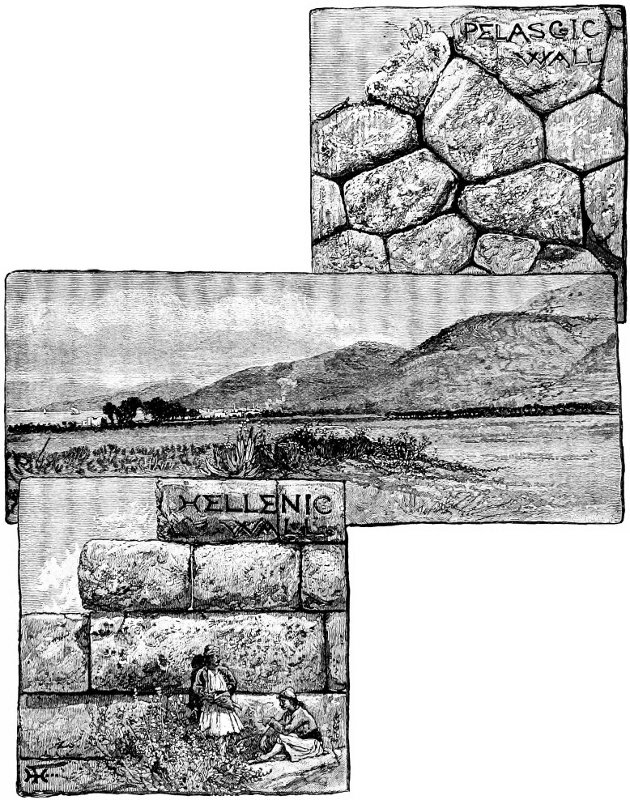
VIEW OF SAMÉ FROM THE WEST,—WITH PARTS OF PELASGIC AND HELLENIC WALLS.
At present Samé is an insignificant village, consisting of twenty or thirty small houses stretched along the beach, with a tiny port formed by a breakwater constructed from the stones of the city wall, the fairest and best cut that could be found. The people are a thievish clan, who set on any chance comer, like mosquitoes on a solitary and bewildered fisherman in a swampy land. They have coins and antiquities to sell, for which, as everywhere else in Greece, they demand the most absurd prices; and they beset one with offers of service as guides, etc., etc., etc., till they weary all human patience. This may be said of the Ionians in general, but less of the people of Cerigo, perhaps, than the others. We found, however, a grateful exception. We had wandered along the beach to the furthermost houses of the line, and on passing a very respectable-looking house, the owner, sitting in the coolness of the twilight at his gates, seeing two strangers, rose to salute us and invited us to enter; an invitation so amiable and earnest that we accepted, and were ushered into the guest-chamber, clean and furnished with divans in eastern fashion, where we were entertained with the usual sweetmeats and coffee, while the daughter of the house went into the garden and collected for each of us a bouquet of roses, the most fragrant I ever remember to have 59 seen. Our host narrated many incidents of the English rule in Cephalonia, and when we rose to go urged us to take up our quarters in his house; and finally, as we stood before the gates, as a last favor, offered me two beautiful Greek stelæ, memorials of the ancient dead, possibly of the period of the heroic defense of Samé. He had found them in digging his house cellar, and they were the ornaments of his court-yard; but learning that we were in search of antiquities, he offered them freely as his contribution. I shall not soon forget him or his fragrant roses and the dark-eyed Saméan girl who offered them to us.
Of Crané scarcely a trace remains, even of the Pelasgic walls. It stood originally on the Lake of Argostoli (to which place we drove from Samé across the island), but at a point now far from the water’s edge. The lake is a singular geological phenomenon, formed by a number of springs bursting out from under the hills on which Crané lay, with a force sufficing to drive mills and form a strong current over the whole extent of the lake, which is a mile or more in diameter, though the surface of land to be drained by these subterranean outpours is, one would say, utterly inadequate to the quantity of water delivered.
I took a guide at Argostoli, a man of the usual type of Greek guide, who assured me that he knew the ancient city, and had often guided strangers there. On arriving at the head of the lake I found him taking useless détours to bring me to the mills, which were driven by the springs; and on asking him what he went there for, he replied that he supposed I wanted to see the mills—since that was what other people had come for. I gave him an energetic sample of modern Greek, and ordered him to show me the way to the ancient city—Palaiokastron. “Palaiokastron!” he ejaculated with surprise and bewilderment in his eyes, and turned to ask some shepherd boys or other vagabonds, who were sauntering 60 near by and watching us, where the Palaiokastron was. They declined to give any information, probably regarding him as a poacher on their preserves. I had, therefore, to depend on my antiquarian instincts, and, taking the lead, climbed over the heights above until, guided by the nature of the ground, I found the traces of the old wall.
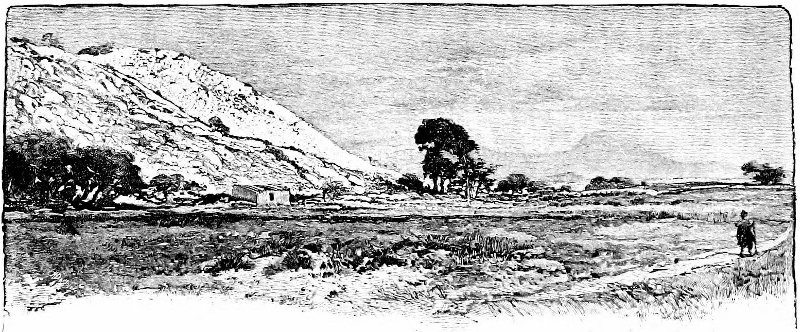
CRANÉ FROM THE SEA SHORE.
The position of the city was entirely characteristic of the sites of the Pelasgic epoch: a bold, double peak, almost inaccessible on the sea-side, and on the two flanks still very precipitous, but connected with higher land on the side opposite the water. On the side from which the view is taken none of the ancient walls remain. The movement of earthquakes, the gradual fall of the rock at the precipitous edge, or the leveling labor of man has carried away all the blocks that made this side of the enceinte; but many of the stones may be recognized at the foot of the slope, some worked into modern walls, and some in the débris of the hill. On the opposite side the traces are more distinct, and the wall may be traced a long way, and the site of the citadel determined, with a gate and the angles of some of the towers. From near the citadel a view is obtained which shows a long line of the débris with a distant view of the town of Argostoli and the lake, and far beyond the lines that form the western shore 61 of the superb harbor of Argostoli, almost without a rival in the Adriatic. The mass of wall is hardly to be distinguished from mere decomposed rock; so much have time and frost, the great demolishers, split and crumbled the flinty, massive limestone, the preferred material of the Pelasgi. On the further shore shown in the view may be seen, when the air is clear, the houses which form a modern village on the site of the ancient Palé. Here were Jason and his fellow adventurers entertained on their search after the golden fleece,—an expedition which perhaps we may translate from myth into probability, as an expedition to obtain an improved breed of sheep, a finer-wooled stock, from one of the northern and inland countries.
At Argostoli I inquired about the ruins of Palé, but was told that they are mainly built over, and what is visible is only of the Roman period. I attempted, however, on our return to Samé, to run around in the Kestrel, as the voyage across the bay from Argostoli is neither pleasant nor sure in the small boats that make the service. We got up anchor as the land breeze began to blow at midnight, and I went to bed, having given orders to anchor in a little bay about half-way to the southern extremity of the island near which some ruins are indicated on the map. Awaking in the morning and finding a most suspicious tranquillity prevailing, I took a look at the outside surroundings, and found the yacht quietly moored on the same spot she had occupied the day before. A furious sirocco had sprung up and met us half-way to our destined anchorage, and after beating for an hour in vain, our little boat nearly buried in the seas, we were compelled to retreat and run back to our former place of refuge. There is no getting ahead in such small craft against the sharp, violent seas of the Mediterranean.
Three days the sirocco blew, and we tried in vain to pass the time fishing. The Ionians have adopted dynamite so universally 62 to catch their fish that they are as scarce as honest people on shore. One does find them sometimes, and we caught a shark about four feet long and a half dozen red mullet where, before dynamite was discovered, we could have caught in the same time a hundred-weight.
The third night we got under way again, and, with a heavy swell still on, ran down to our harbor, reaching it as a flaming, splendid thunder-storm was coming up, the finale of our southern blow. We moored with cables out in three directions, and when the storm had all gone by I went ashore to hunt my ruins. A vagabond Cephalonian offered his services to carry my camera and guide me; but his crafty and evasive face, coupled with the assurance with which he clung to me, so irritated me that to rid myself of him I plunged into the pathless thicket. Traveling by compass, and searching long and closely, I found at last the remains of an early Pelasgic wall on a magnificent site, with a breezy outlook to sea north and west and overlooking a fertile valley inland, not especially pictorial, for it was too regular and too thoroughly cultivated, but through it ran a bright crystal brook overhung by huge pollard sycamores and fringed with oleanders just bursting into blossom and making the valley look like a rose-garden. Beyond the hill on which the city stood is a wild ravine through which runs the brook, which in Greek would naturally be dignified by the name of a river. Only a narrow neck, as usual, gave access to the site. It is impossible to ascertain with any kind of assurance what the name of the city was. It could not have been Nesia, the only one of the four principal ones we have not visited, for no ruins are visible approaching so late an epoch as the Roman, and it was probably Heraclea. Its position was magnificent for defense and on account of the fertility of the country behind it, but the site was probably abandoned very early for one further inland, where I was assured there were ruins of an ancient 63 city. But my time had been so invaded by the loss of three days through the storm, and I was already so behind my programme, that I was not able to give the time necessary to the search and examination, or, indeed, to follow my plan of visiting Palé.
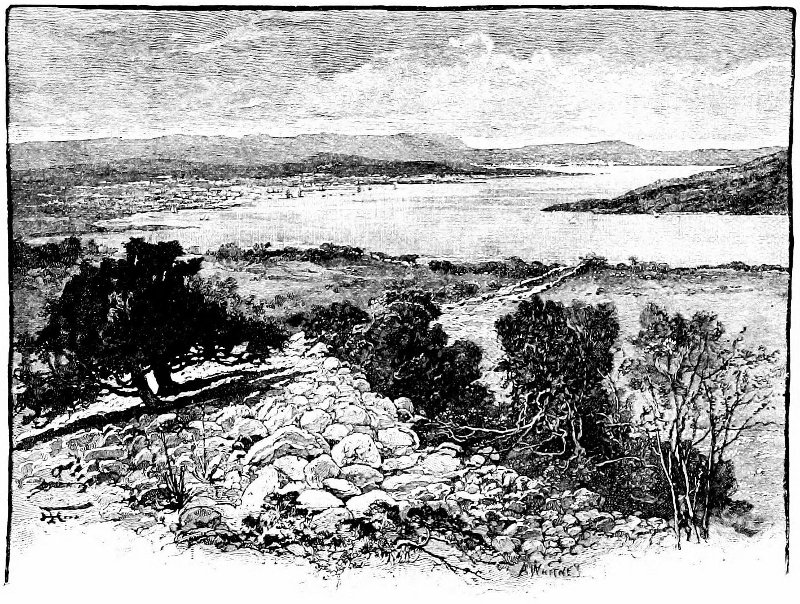
DISTANT VIEW OF PALÉ FROM THE CITADEL OF CRANÉ.
We climbed down to the brook, and I enjoyed the pastime of wading in the gurgling water as if I were a boy—it was so long since I had had that pleasure! We followed it into a close and gloomy gorge, where the crag of the ancient site overhung us like a huge, rough wall, almost a sheer precipice, and down at the foot ran the brook, which we followed to the sea. The sun was setting as we reached the yacht, and before we waked from sleep next morning we were bounding toward Zante.
In Zante (Zakynthos) there is, so far as I could find, no ancient ruin whatever. The character of the rock explains this; for, except at the extreme southern end of the island, 64 there is no stone which would resist even the weather-wear since the Roman epoch. The island seems to be a bed of sand raised from the sea and slightly hardened, so that, though the citadel hill is imposing enough as a mass, the material of it is being continually dissolved, and looks at a distance more like a bank of clay than like rock.
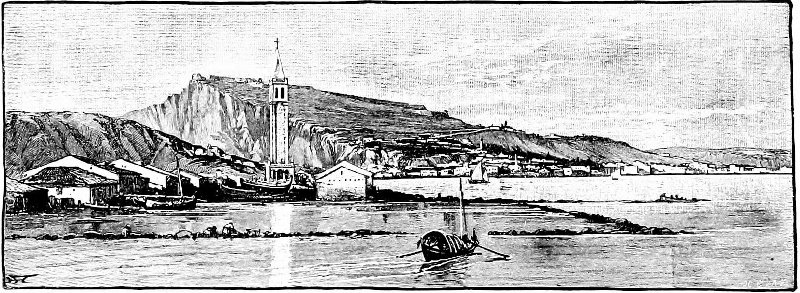
ZANTE.
Zante is rhymingly called the “fior di Levante” (flower of the Levant), but it is difficult to see wherein it surpasses Corfu in any flowery attribute. I guess that, as in many other cases, the rhyme went for more than the fact, poetical or otherwise. It is fertile, and the land extends in an immense unpicturesque plain covered with olive-orchards and vineyards for miles from the port. Its history is unimportant and its mythology not interesting. It was said to have been colonized by Zakynthos, son of Dardanus of Troy, about 1500 years before Christ; but, as I have before said, all Greek dates and traditions of migration earlier than 1000 B. C. are purely conjectural. Zante suffered with the other islands from the endless and furious feuds of the Greek states; ravaged by turns by Athenian and Lacedæmonian, it came down to the Romans an unruly subject province, conquered and reconquered, and finally lay still in the tranquillity of slavery until Geneseric, king of the Vandals, began an epoch of devastation, which only concluded with the purchase, by the Venetians 65 from the Sultan, of its soil depopulated by the sword and slavery.
He who goes about in the Mediterranean has great chance of seeing bad weather, for it is the reverse of a pacific sea, and in a scrap of a boat like the Kestrel the phenomena are sometimes interesting. Our course from Zante to Cerigo (ancient Cythera) leads by Cape Mátapan, opposite Cape Maleá, the two southern points of Greece, which enjoy a reputation of the kind that the American proverb gives to Hatteras and Lookout. The Kestrel was again baffled, and, after beating for hours to get past the point, we had to put up the helm and run back to Navarino, the nearest shelter, before a gathering southerly blow. We lay in our old anchorage another day, and as the wind fell at night we beat out again and ran through the little archipelago of barren and desolate islands which lie off this part of the Morea. The weather still looked ugly, and thunder-clouds were gathering on the hills of Lacedæmon, and we could see the storm creeping down toward the sea, but the wind was fair, and we hoped to make Kapsali, in Cerigo, before the squall came down. Already the heights of Cerigo loomed before us, and we had begun to look for the landmarks, when the wind struck us. All hands made what haste was possible to get in sail and get up a small storm jib to lie to under, and not too quickly, for no common canvas would have stood that blast when it struck us. The sun was setting, and soon we were out of sight of all land in the driving spray and rain. The lightning was such as only they who sail in semi-tropical seas can have known, blinding and incessant; it seemed to have gathered around the mountains of Cerigo as a centre, for it went and came and still hung there as the rain swept down the coast and up again. As the wind fell off with the down-pouring of the torrents we got off again and pointed our bowsprit for Kapsali; and as the waters above and those below seemed to have formed an alliance against 66 us, we went below and shut the hatch. Fortunately the wind was off shore and we had little sea, and managed to creep along nearly as much as we had drifted to the leeward; so that when the storm broke and the rain held up we were able to see the rocks off the coast, and finally to grope our way into the little port of Kapsali, which is secure against everything but a southerly blow. The wind, always contrary, fell off as we drew near the light-house, and we had to get in with our sweeps in the small hours of the morning, wet, cold, hungry, and jaded from the excitement of the night; for, though it is simple and safe in the telling, a large Greek brig foundered only two miles from us in the squall, and we had experienced the worst weather we had yet felt, and since the storm began no one had been able to eat or even get a cup of coffee.
At Kapsali one begins to see the antique sailor ways and the evidence of the intense conservatism of the eastern world. The ships are drawn up on the beach at night as of old, and this necessitates a construction of the hull which cannot be far removed from that of the antique. Indeed, I have seen fishing-boats which might have served for the models of the galley on the Roman coins. The rigging, again, is of the simplest, and fitted for these seas, where the sudden squalls and the “meltem,” or gusts which come down from the mountains with no warning but a little cloud appearing on the summit, sometimes leave brief space for the taking in of sail. On the whole, wherever we look we see ample evidence that in the whole Levant, where the original population exists in a considerable proportion, the ways of life and thought are the same as those of Homer’s day. Nature has changed more than man. Where the Venetians came they brought new habits of military life and construction, and demolished all the old ruins to make fortresses; but on the domestic life and on the character of the Greek they had little or no influence.
Whether Kapsali, a mere village, the port of Cerigo, had any ancient existence, we do not know. Cerigo lies on the high rock above it, and is a Venetian fortress; and, as is generally the case with Venetian fortresses, has used up all ancient masonry, if any existed, in its construction.
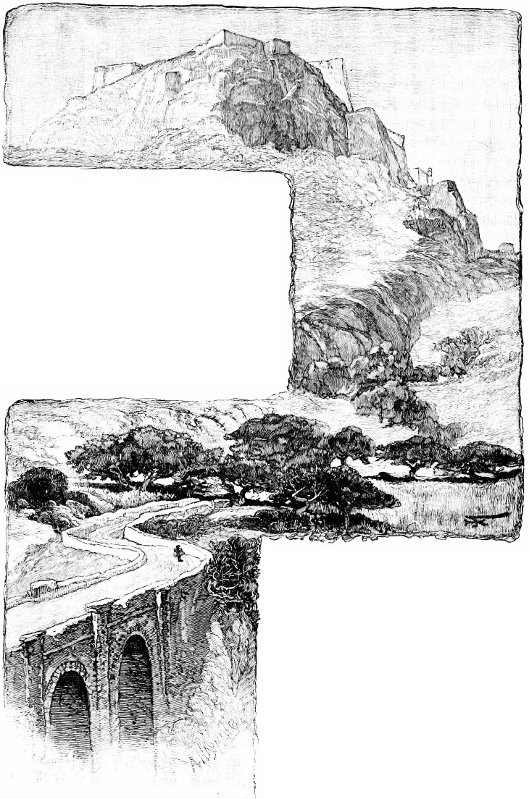
CITADEL OF CERIGO.
The road from Kapsali to the town of Cerigo is of Venetian construction, kept in repair by those fitting successors of Venice, the English, who certainly left the Ionian Islands in a state of prosperity higher than that of to-day. Good roads were almost everywhere provided, and good ways of other kinds, now lost entirely, if I might believe the complaints of the people. The 68 position of Cerigo is very strong for the days of Venetian rule, and it overhangs the port and country round on every side, except one, like a Pelasgic site, but I could find no stone of that date. It is not likely that there was any very ancient city there, as no tombs or evidences of a necropolis have been found. The formidable character of the position in the times of the Venetians is shown by the view from the road above the ravine which severs the mountain from the lesser hill over the port—a ravine whose existence is quite unsuspected from the port.
The city itself is without interest except as the first really Eastern city one will see coming from the West, and as an example of Venetian fortress-building. The view from the citadel is fine and breezy, the islands of Ovo, Cerigotto, and Crete being visible, and a great expanse of that sea which, on sunny days, is in itself so beautiful from its color. You look down on the houses, white as continual whitewashing will make them, whose flat, terraced roofs serve in the hot and rainless summer as sleeping-places for the whole family. How many nights I have dragged my mattress from the bedroom out on this delightful substitute and let the night breeze fan me to sleep!
Of history the island has next to none. Mythology puts the landing of Aphrodite here, as she came, foam-born and sea-borne, to found her religion in the Greek worlds.[7] The first who are traditionally reported to have colonized the island are the Phœnicians; but it is impossible to ignore the previous coming of the Pelasgi, who have left a well-marked ruin of the earliest type. To see the traces of the antique settlements, one had better go to Port San Nicolo if provided 69 as we were; but secure an intelligent guide previously from Cerigo, as the country people, as in other islands, while pretending to know all about the antiquities, really know absolutely nothing. They know the tombs because they serve as sheep-folds, and they have sometimes a curious knowledge of the relative antiquity of the ruins; but they have heard modern myths, and apply them with the least possible regard to archæological facts, and invariably assure you that they know everything.
So it happened that I was again, for want of choice, out on a search with an ignorant guide. There had been some excavations commenced on the site of what is now known as Palaiopolis (the old city), which evidently was Phœnician, and was occupied down to Roman times. There were some columns of Roman or Byzantine work unearthed, and from mere curiosity to know his notions, I asked a shepherd boy watching his sheep near by what they were. “This,” he said, “was the palace of the king.” “Of what king?” I asked. “Don’t you know?” he said, opening his eyes at me as if this were the very a b c of history. “Why, the palace of Menelaus.” There is an old tradition that it was the place of residence of Menelaus and Helen, and all the objects to be seen are attributed to them. The Phœnician city is close to the sea; the Pelasgic site is several miles back, and looms up on the highest mountains in the vicinity. In a previous visit I had seen but had not explored it; but now I determined to see the whole extent of it. My guide, who brought a donkey for my occasional changes of mode of locomotion, pretended to lead me to the ancient citadel; but when we reached the hill on which I knew it to be better than he, he began to inquire about it of the women at work in the fields; thereupon I, as usual, took the lead. Guided by the nature of the ground, I found all that remained of the ancient citadel wall—a fragment kept up by the chance of its being the limit of 70 a field, and so kept in repair, but in such a state of dilapidation that but for the evidences of the continuity I would not have been sure that it was a wall. I followed the main wall a mile or more along the edge of the precipitous slope, and saw that it bore testimony to the importance of the ancient city, for it was wide in its compass and massive, with towers, gates, and flanking towers of the true Pelasgic style, but in most places only two or three stones high. I got an imposing view of the hill from below the lowest trace of wall, showing its position with reference to the valley below, through which ran once a river of some volume, if we may judge by the alluvial plains at its mouth, but which at the time of my visit in midsummer, was dry as desert dust. A strip of white pebbles shows where it still runs in winter-time. On the hills close to the sea-side, and on both sides of the mouth of this ancient river, used to lie the old Phœnician, Greek, and Roman city, whatever it was originally called,—probably Cythera, like the island. As I have said, it is now called Palaiopolis. The temple of Aphrodite, the people pretend, was on the hill near the citadel where now is an insignificant chapel, but with no evidence of antiquity except that there are in the construction of the chapel some large stones which are evidently of Hellenic cutting; but as the Greeks had the habit in all ages of keeping up the temples of their gods, there is nothing to show that it was a temple of Aphrodite rather than a Pelasgic god, which Aphrodite-Astarte was not, and her temple must have been near the sea.
The site of Palaiopolis is marked by a quantity of tombs, most, if not all, of Hellenic date. There are now no temple remains there; but Spon, who visited the spot two hundred years ago, says that he saw the statue of Aphrodite, which was very ugly and of coarse brown stone, which reminds us of the statues of Cyprus. The rock is a soft conglomerate which the sea cuts away very rapidly, and apparently there 71 has been a subsidence of the soil, since they say that when the sea is tranquil there may be seen beneath the water, some distance out from the actual shore, the ruins of a city. This may have been the port of Cythera—scarcely a fortified city, as the site must have been too low. Right and left of the rivulet which now represents the ancient river are bluffs of conglomerate, that on the left honeycombed by tombs, some of which have fallen with the rock, but of which others are still visible, opened to the elements but showing within the rock-cut graves. Many valuable articles of gold work have been found in past times, but the treasure seems to have been exhausted. These two bluffs are the lineal representatives and successors by right of position of what Aphrodite must have seen as she came ashore on the foam, otherwise they have no interest.
The two low hills which were included in the city of Cythera are covered with fragments of building and traces of tombs, but, so far as I could find, no wall. This is all that is left of Aphrodite, Helen, and Menelaus in their land of fabled existence. The coming ashore of Aphrodite undoubtedly indicates, like that of Europa at Gortyna in Crete, the landing of a colony from Phœnicia, bearing the worship of Astarte, who became later assimilated to Aphrodite. Of the presence here of Helen and Menelaus there is no evidence in any trustworthy tradition. The subjection of Cythera to Sparta is of historic date. My conclusion as to the island is that in Homeric times it was Phœnician in its relations as Melos was at one time, as well as Santorin and other eastern islands, and that, like Corfu, it did not come into the Greek system.
Opposite Cerigo, and with its snowy peaks glistening under the noonday sun, lies Crete. The strangest omission of the Odyssey would have been that of the island of Minos from its reminiscences, if the author had known of it; but, as we 72 have seen in his interviews with Athene, Ulysses did not fail to include it in his geography though he had apparently never visited it, and like Egypt and Lotophagitis it was known by report. Of Egypt we had heard mention through the visit of Helen and Menelaus. Of the country where subsequently was established the Great Greek-African colony, Cyrene, we have no hint, yet the inhabitants of the Peloponnesus knew of Libya earlier than the Dorian invasion—as early, in fact, as 1500 B. C., as we know by the Karnac inscriptions. The story of Eumæus shows knowledge of the ways of that race of merchants and pirates, the Phœnicians, but nothing of their country.
The questions of the personality and date of Homer and of the reality of the Trojan war are utterly diverse, and not, in fact, interdependent. As to the latter we have thus far no direct evidence whatever, beyond poetic traditions in which the supernatural is so strongly and inextricably involved with the pretense or actuality of history that no inferences can be drawn from any part of the narrative, though from its ensemble we are assured that in its ancient form it was accepted as history by the entire Greek world as early as we know anything of that world with historical certainty. But that is no criterion. Even at this day myths grow and crystallize in the Oriental mind with a rapidity which leaves the ancients without any advantage. The universal belief from the first to the eighth century B. C. that the Iliad was history need not weigh with us. Scientific investigators differ so widely that we have no general inference to draw from their arguments. The most recent excavations leave a grave doubt whether any of the ruins excavated in the Troad can by any reasoning be admitted to be as old as the Iliad, and the remains on Hissarlik hill which Schliemann more suo has identified with Homer’s Troy are clearly the remains of the city of Crœsus, being of brick, which does not appear in the classic 73 traditions or structures until his time, and we know by authentic history that he did build a city on this hill. Professor Jebb, one of the most acute of the literary investigators of the question, is convinced that the topography of the Iliad is eclectic, some of its indications suiting only Hissarlik and others only Bunarbashi; Max Müller maintains that the whole story is a solar myth; while Nicolaïdes, a patient and thorough Greek student of the Iliad, believes that he can follow the whole strategy of the poem on the plain of Troy. But the main questions involved in the Odyssey are of a different character and determined by different criteria. I offer my suggestions as to some of them with the deference due my masters in archæology.
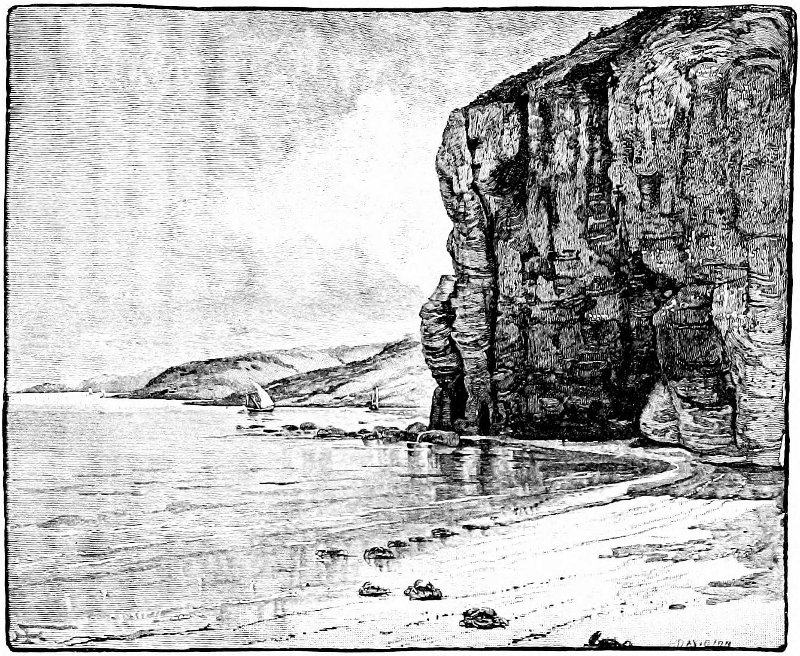
LANDING-PLACE OF THE CYPRIAN APHRODITE OR ASTARTE.
The general knowledge shown in the Odyssey divides itself into kinds: that which was part of the general geography of the day, and this included the coasts shown on our route map; and that of which the poet had personal cognizance, 74 which is limited to Corfu, Ithaca, Nericus, and possibly Pylos; and this exclusiveness suggests to us that Homer, a stranger in the West, had come, as I did, simply to follow and study the traces of Ulysses’ wanderings, and that he did so in obedience to a clearly preserved tradition as to his great exemplar, which was almost impossible without the still remembered personal presence. What he describes is admirably told, even to the “sandy shore” of Pylos, in a world whose sandy shores are rare; but Homer does not seem to have any mental vision of the lands and islands of which Ulysses only speaks in his story—the lands of the Cimmerians, of the Læstrygonians, the Cyclops, the Lotophagi, the homes of Circe and Calypso, are only heard of. Cythera, close by, is not named, and Crete and Egypt are only named. This kind of fulfillment, as well as this kind of omission, gives a tone of personality to the poem, as the composition of one person, and that one familiar with the scene of its major events, and it strengthens my belief in the hypothesis of the presence of Homer in Ithaca, and of the early date of the Odyssey, and by a certain implication argues for a logical relation between the hero and the Trojan war, implying the actuality of both.
In the year 1820, before the struggle between the Hellenic population of the Turkish empire and the Porte had begun, and when all that attracted the notice of the civilized world to modern Greece was the little preserved to us of her art,—occasionally and fragmentarily found in the ruins of her great communities,—a peasant of Melos whose name was Theodore Kondros Botoni, working in his field to enlarge it by clearing away the débris of the walls and structures of ancient Melos (which had been built on a steep hill-side, on a series of terraces, more or less natural or artificial, so that the ruins of one terrace fell down upon and encumbered that below it), saw, to his great bewilderment, the heap of rubbish which he was digging away at the bottom suddenly crumble down and display the upper part of an antique statue. The peasant hastened to the French consul to inform him of the discovery, and the latter negotiated the purchase of it for five hundred piastres and a complete dress of the fashion of the country. This was the statue known as the Venus of Melos.
So far, there are no variations of the history, but one account says that the first or upper part was found several days before the lower, and the other, that they were found together; but the inexactitude of the documentary contemporary evidence is clear from the examination of the ground to-day, and from the contradictions contained in it. Dumont d’Urville, the commander of the Chevrette, a French man-of-war which visited Melos after the statue was found, alluding to the discovery of the theatre, says: “All the ground is 76 covered with drums of columns and fragments of statues. One finds here and there great pieces of wall of a very solid construction, and many important tombs have been opened through the curiosity of strangers, and the cupidity of the inhabitants.” But neither the wall nor the tombs, nor any drum of column or fragment of statue (if any was found), could have had anything to do with the theatre. The theatre is very late work, and was never nearly finished, so could have possessed neither columns nor statues. This shows that the idea the commandant carried away was confused and untrustworthy as to details. He goes on to say: “Three weeks before our arrival at Melos, a Greek peasant, digging in his field inclosed in this circuit, struck some pieces of cut stone. As these stones, employed by the inhabitants, have a certain value, this induced him to dig farther, and he thus happened to uncover a species of niche, in which he found a marble statue, two Hermes, and some other marble fragments. The statue was in two pieces, joined by two strong iron clamps. The Greek, fearing to lose the fruit of his labor, had carried the upper part to a stable. The other was still in the niche.... It represented a naked woman, whose left hand raised an apple and the right held a drapery,[8] well composed and falling negligently from the hips to the feet. For the rest, they are both mutilated, and actually detached from the body.”
I note by italics the points which are to be contrasted with other evidence.
M. Dauriac, captain of the frigate La Bonté, writes from Melos, date 11th of April, 1820: “There has been found, three days ago, by a peasant who was digging in his field, a marble statue of Venus receiving the apple from Paris. It is larger than life; they have at this moment only the bust as far as the waist. I have been to see it.” Mr. Brest again writes, 12th of 77 April: “A peasant has found in a field which belonged to him three marble statues, representing, one Venus holding the apple of discord in one hand, the other represents the god Hermes, and the third a young child.” The correspondence shows that Mr. Brest was entirely ignorant of everything connected with archæology or art. He probably heard one of the officers say that one of the objects was a Hermes, and he changes it into a statue of the god Hermes, but we see that there was only one Hermes. November 26th, Brest again writes: “His Excellency has left me orders to make researches in order to find the arms and other débris of the statue, but to do that it is necessary to obtain a bouyourouldon which will permit us to make excavations at our own expense, because in the same niche where it was found there is reason to hope that we might find other objects.”
The contradictions are so palpable that it is clear that these documents are only of value as secondary archæological evidence. No one seems to have made an observation with exactitude.
We have the whole statue found, in one, bound together by iron clamps; in another, only half had yet been found; in one, the statue is found holding the apple of discord in one hand; in another, receiving it from Paris; and in another still, we are told that search has been ordered for the arms, etc.
In 1865 I visited Melos, and having made the acquaintance of Mr. Brest, son and successor of the French consul who secured the statue for the Louvre, he politely offered to guide me through the ruins of the ancient city. Among other things, we visited the locality where the statue was found, and he showed me the niche still standing as when the discovery was made.
It was a slightly built work, of the height, as nearly as I can remember, of ten or at most twelve feet, and about five 78 wide. It formed a part of an old boundary-wall of the field on which it opened, and above it the ground was level with the crown of the arch of the niche. It had no suite or connection with any other structure, except the boundary-wall in which it was, and there were no evidences of ruin or of foundation of antique buildings about it. The opening had been closed with rubbish, not with masonry, as was evident from the face of the side walls, which were of smooth, if not carefully laid, masonry. If as I believe not built for the concealment of the statue, it had been made for some unimportant purpose; perhaps the protection from the weather of the poor Hermes which is said to have been found with it. C. Doupault, architect, has published a brochure with what he supposed important evidence on the question, in which, from data given him by old Brest twenty-seven years after the discovery, he reconstructs the apse of a seventh-century church, in which he places the statue. The whole study has no value whatever, as the sketch does not correspond with the ruins which I saw, and looking back to the correspondence quoted, it is clear that Brest, knowing nothing of archæology or art, caught at certain suggestions of the officers who saw the statue, and affirmed what they surmised. As to the fragments found, to which constant reference is made, there is not the slightest evidence that they were found in any connection with the statue, as none of the early evidence indicates that they were known when the statue was first taken under notice—on the contrary, it is said explicitly by Brest that he had orders to make researches to find the arms and other portions of the statue; indicating clearly that the arms alluded to had not been found with the statue, and that the connection between them and it was an after-thought, either of the peasant, who wished to increase the value of the statue by connecting with it fragments which he had found in other parts, or of the archæologists, who, seeking to restore the statue to what 79 they judged to be its true action, connected the arm found, no one knows where, except at Melos, with the statue. It is undeniable that when the letters before quoted were written, there had been only conjecture as to the arms. Dauriac, writing on the 11th of April, says that they have only found the bust. Brest, November 26th, says that there is reason to hope that they might find other objects in the same niche—proof that it had not even then been cleared out. In fact, all we have of documentary evidence goes for nothing beyond showing that the statue was found at a certain place on a certain date; and if the two halves of the statue did not fit exactly we could not be certain that they were found at the same time and place. The hypothesis of the apple of discord is based on a conjecture of some of the officers, and has no further confirmation than that an arm and hand, with what may be an apple or a cup, seem to have been found somewhere in the island about the same time; but they evidently are not of the statue, nor even of the same epoch.
Over or somewhere near the niche an inscription was said to have been found which records the dedication of an exedra by a gymnasiarch to Hercules and Hermes. The date of this inscription, according to conjecture based on the inscription itself, is about a century before Christ, i. e., long after any possibility of such a work being produced had gone by.
These are all the positive data we have to work on. They suffice, however, for about twenty monographs in French, German, and English; and a late German work, by Dr. Goeler von Ravensburg, exhausts all the possible and impossible conjectures to establish its character in accordance with the original attribution of a Venus receiving the apple.
In the year 1880, I made another visit to Melos, on commission from “The Century” magazine, to photograph whatever might remain which had any connection with the statue; but found the niche gone, and no trace of foundations of any 80 kind, or walls, city or other, very near the spot which was again pointed out to me as that where the Venus was found.
It would seem that in the energetic excavation that followed the last great archæological revival, everything that was suspected to conceal works of art had been dug away.
I found an old man, a pilot well known in our navy, Kypriotis, who had seen the statue when it was brought out, being a boy of about fourteen. At that time Mr. Brest was a child, and retained only slight personal recollection of the event; but it was evident that he, like his father in 1847, had mingled in his impressions conjecture of others and his own, with facts perverted, and details conceived without sufficient basis. Nothing new was to be got.
The old Melos is utterly deserted, and the modern town is built on a pinnacle above it, which does not seem ever to have been included in the range of the city. The port is changed from the ancient site, where now a breakwater would be needed, as the land seems to have sunk greatly, and the old basin of the port is silted up to a point at the bottom of the bay, where a comparatively modern village has grown up, called Castro.
The magnificent harbor used to make of the island an important station before telegraphs were established, and might again, if the telegraph were laid to it; but now a man-of-war rarely calls, except to take a pilot for the Archipelago, and a Greek steamer stops once in a fortnight. But in heavy weather, any ship caught near runs for Melos. This keeps the place alive, but it has dwindled to a mere island village, where the vast labyrinths of tombs which perforate the hills show more human industry than the dwellings of the living. Earthquakes and malaria have desolated and almost depopulated it.
We had left Cerigo for Crete, and intended to take Melos on our return to Peiræus, but when within an hour of land 81 we were caught by a terrific south-wester, the most to be dreaded of all the winds of the Ægean, and in spite of all we could do we were obliged to give up and run before the gale where it would send us. It was late in the evening when its fury came down on us, and taking in all sail except a small storm-sail at the foot of the mast to keep from coming up into the wind, we ran before it into the black night. I knew that there were no rocks ahead before Melos, and if we only made the island by daylight, we could easily fetch the port; but if not, and the yacht ran at night into the little archipelago of which Melos is part, it would be next to impossible to choose where our bones should be laid, for there are no lights, and many islands and rocks. The sea was, for our little twelve-ton craft, something fearful, and we thumped and hammered till the little thing quivered, when a wave struck her, almost as if we had come to the rocks. Sleep was out of the question—to sit or stand, equally so, and we kept to our berths, as the only way to avoid being pitched about like blocks. How long that night was! and in the middle of it I attempted to get up, and when I put my foot on the cabin-floor, found myself stepping into the water. We had sprung a leak with the straining.
But day came and cheerfulness. We ran in between the huge cliffs which form the portal of Melos harbor, with the wild surges beating against them till the spray flew high enough to have buried a larger craft than ours. Tired, aching, and hungry, for nothing could we get to eat till we arrived in port, we cast anchor in the welcome harbor late in the afternoon. Even then, the sea ran so high that we could not land until the next day.
Castro is a pile of white houses, rising in terraces from the shore; the streets mostly stairways, and the houses all whitewashed till they blind one in that rarely broken sunlight.
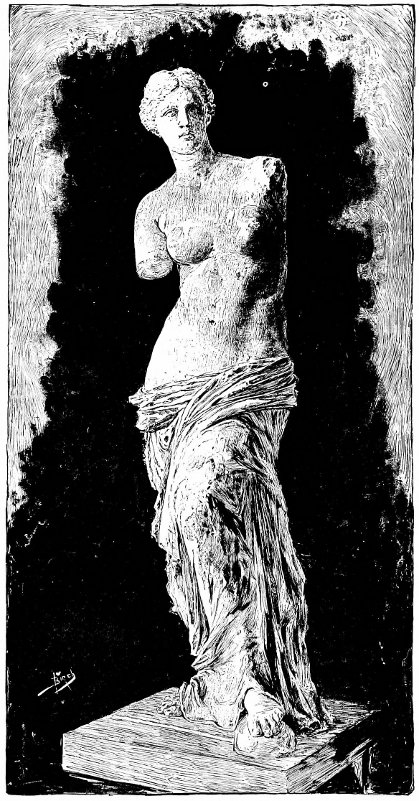
THE SO-CALLED VENUS OF MELOS. (DRAWN BY BIRCH FROM A PHOTOGRAPH.)
I landed, and, as usual, went to the little café, where the magnates of the village were discussing the arrival and the storm—the worst, they said, for many years. I called, of 83 course, on Brest, who, to my surprise, remembered me after eighteen years; and we made an appointment to revisit together the sites I knew, and to see those I had not known before,—important excavations having been made since my former visit.
We went first to the new port, where some admirable statues, since taken to Athens, had been recently found. The owner of the little field by the water, which occupies the site of the inner port, having occasion to sink a well, struck the ruins of a temple of Neptune, and three statues were found, one of Neptune, a female goddess draped, but lacking the head, and a mounted warrior, apparently Perseus.
The Greek Government, according to their laws, forbade the exportation of them by any foreign government, and finally purchased them for thirty thousand francs—certainly a very small price. I succeeded in seeing them later, still in their boxes at Athens, and though not equal to the Venus, or of the same epoch, they are very fine works.
But there the excavations stop; the owner had no means to pump out the water that flooded his diggings, the Government had no more, and as no one is allowed to dig unless for the Greek museum, whatever remains under ground and water is likely to remain there another generation.
We then climbed up the zigzag road to the theatre. It is, as I have said, of late times, probably Roman, and was never complete. Fragments of unfinished ornament lie still where the stage should have been, but it had clearly never been carried up above the seven ranges of seats now existing. It was just outside the wall of the inner city, on the brow of the hill, and overlooked the spacious harbor and looked out to sea. There is no record of any sculpture having been found there. It was purchased and excavated by the King of Bavaria.
Less than half a mile beyond, going with the sea at our 84 backs, was the field where the statue was found. The Greeks have entertained a great deal of indignation at the rape, which they affect to call robbery; but the civilized world may thank the French captain who, coming to get it, and finding it already half-embarked on board a Turkish vessel, destined for Constantinople, made the most legitimate use that was ever made of force majeure, and took it away from the Turk to transfer it to the hold of his own ship. Otherwise, no one knows what vile uses it might have gone to, or what oblivion and destruction. All the world knows it now, but Greek genius would have forever lacked one of its greatest triumphs in modern times if it had disappeared in the slums of Stamboul.
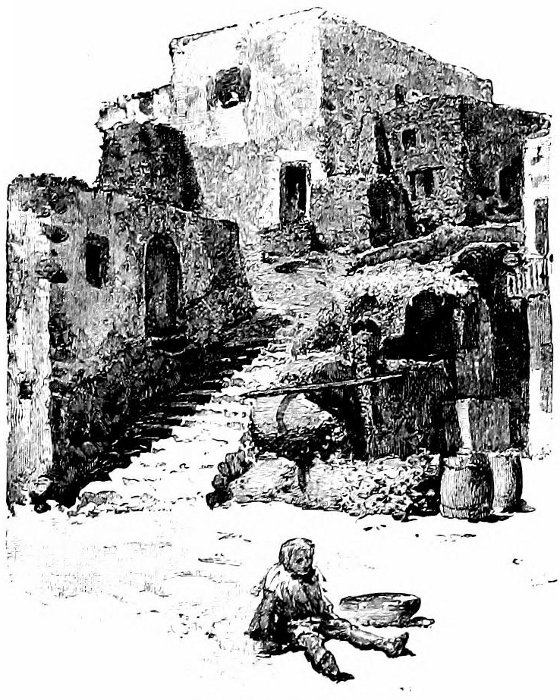
STREET IN CASTRO.
As I have said, there is now no trace of any construction of any kind to be seen at the locality. The wall in which was the niche was gone, and the field of the present owner has encroached considerably on the space beyond, the débris being piled up in huge masses like walls, and two or three terraces above runs the citadel wall, a mass of Hellenic masonry built of blocks of lava. The Pelasgic walls, of which some authors speak, do not exist anywhere in the island. Brest took up a stone, and as we stood on the wall of débris above, cast it into the field, and said, “There stood the Venus!” In the illustration I have put a white cross on the spot.
There cannot remain the slightest doubt that the statue had been concealed, and to my mind, the circumstances indicated for its concealment are these: The niche, judging from 85 its character, had been built in Roman times; as the rubbly nature of the masonry indicated, probably covered with stucco, as it would have been if intended for ornament, and was designed as a shelter for an altar, or for the statue of some divinity—Terminus, Hermes, Pan or Faunus, the more Roman companion of him. Here the inscription and the Hermes found furnish a plausible clew, and agree with the indication of the masonry in pointing out the epoch of this conjunction of circumstances as subsequent to the second century before Christ; how long after we cannot in any wise indicate.
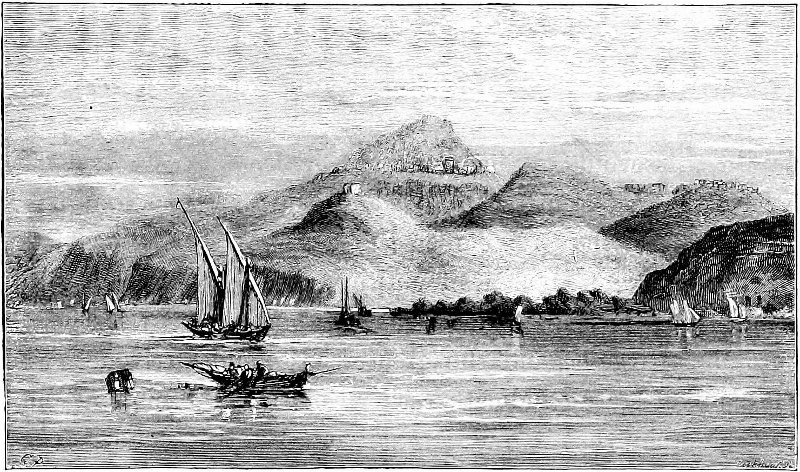
THE SITE OF OLD MELOS, FROM THE PORT. (WHITE CROSS SHOWS WHERE THE “VENUS” WAS FOUND.)
Now as to the epoch of the statue there can be no doubt that it was of the immediately post-Phidian epoch; and all the most authoritative opinions attribute it to the Attic school, and probably of the time and school of Scopas—and some of the weightiest authorities have accepted Scopas himself as the author.
Anything more definite than this it is impossible to establish by any now known evidence. The concealment of the statue, then, was several centuries later than the execution of it.
The Greeks of the classical epoch, even down to the first century after Christ, retained, amidst all the degradation of their contemporary art, a distinct recognition of the excellence of the elder work, as the enormous artistic as well as pecuniary value of some of the masters’ chefs d’œuvre prove. That this was one of them, and of one of the chief masters, all civilization agrees, and, although we have lost the name of the author, the people who hid it must have known it well. The availing themselves of the niche, ready-made to their hands, indicates that the possessors of the statue worked in haste, piling up stones in front of the niche, instead of walling it up.
This indicates the haste of impending attack, or work done in secret. In either case, if the statue had a temple in that locality, it would be concealed near it, or near the place where it was accustomed to stand; but no such temple is known. We may remember the contrast with the colossal and magnificent Hercules found in a drain at Rome, carefully covered over with good masonry. Concealment was the object in both cases, and the greater haste and furtiveness with the Melian statue indicate rather that it was brought from a distance than that it could be a divinity of the island.
Conjecture as to the origin of the statue, if my hypothesis is true, points to Athens, not only because the work is Attic, but because we know by the coins of Melos, which in all the latest coinages still bear the owl of Athens, that Melos belonged to that city as late as she had any Greek allegiance, which must have been some time into the Empire, as the Romans long made it a policy to preserve a certain kind of autonomy in the Greek states, even when their subjection was complete. That it is Attic, no one can doubt in face of the evidence I shall show. That Athens was the only city likely to send to Melos a treasure of this kind, concealment of which was impossible in Athens, is almost certain.
I conclude that it was a highly valued statue of Athens, sent to Melos in time of great danger, to be concealed and preserved. What period this might have been is only to be guessed at; it is therefore hardly worth while to say more about it, except to indicate that four periods in late Athenian history might furnish the motive requisite: when the army of Mithridates, under Archelaus, took Athens; the wars between the factions of Marius and Sylla; the Lacedemonian war, and the invasions of the Iconoclasts. The Romans do not appear, in spite of all their plundering and the enormous quantity of statues carried away from Greece, to have desecrated the temples of the Greek gods, as we see that Pausanias, in the century after Christ, found the most valuable of them in situ, as, for instance, the Diana Brauronia of Praxiteles, the Perseus of Myron, with others of great fame. The above conclusion, considering all the known and reasonably conjecturable details of the discovery and concealment, seems to me justifiable,—as well as that it was concealed at some time between the century or two centuries before Christ and the end of the first century after.
Now, what was the statue? We have so long been in the habit of accepting all female statues, not distinguished by well-known symbols of their divinity, as Venuses, that we make no distinction even in cases where the type demands it. And yet the dominant characteristic of Greek sculpture is this close adherence to established types. We are never at a loss to distinguish Diana, Minerva, Juno, or even Ceres and the lesser deities. Venus, it is true, came into vogue as subject for the sculptors of sacred statues later than some of the others; but all that we know of the Venus of the artists indicates that it was par excellence the womanly type. The treatment of the head in Greek sculpture was a point apparently of doctrine, as it was in Byzantine and in the later ecclesiastical art of Greece. It is always in a conventional type, utterly separated from the individual.
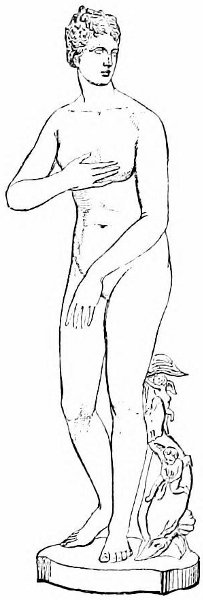
MEDICEAN VENUS.

VENUS URANIA.
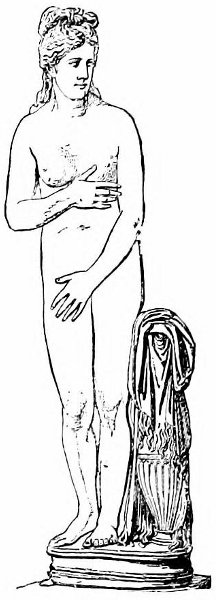
CAPITOLINE VENUS.
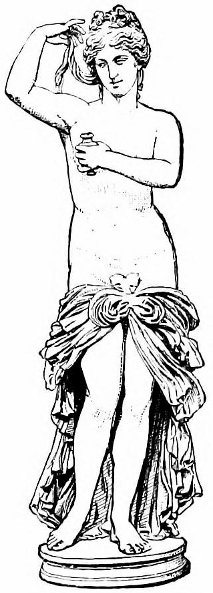
VENUS OF THE VATICAN.
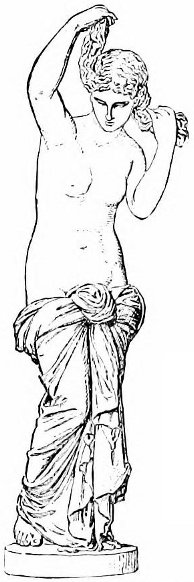
VENUS ANADYOMENE.
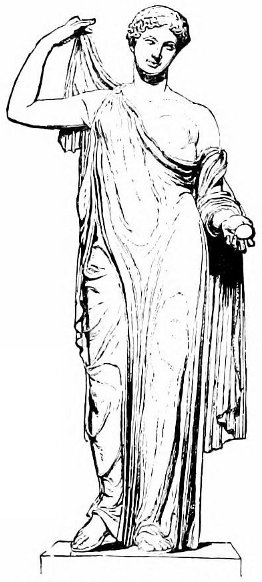
VENUS VICTRIX OF THE LOUVRE.
This unquestionable fact should have taught us to reject from the Venus category many statues which are now included in it, as for instance, the Callipyge, and all in which a trace of portraiture is to be found, besides diminishing that category by all the statues of the heroic type, as in none of the legends of beliefs of the Greek faith was Venus ever endowed with a heroic quality. The preconceived notion that the Melian statue was a Venus has been a continual cause of confusion. This was, as I have shown, the first hypothesis of the French officers, none of whom appear to have been possessed of any archæological knowledge, and who had the commonly prevailing notion that any nude statue must be a Venus. I have taken the pains to collect a number of representations of the various so-called Venuses, and most of which the type, or symbols, justify us in so classifying; and a comparison of their character will show what is the Venus type,—making this proviso, however, that we have no other than internal evidence for denominating most of them Venuses. The chief of these, in what we seek for most, i. e., the impersonal type, which was inseparable from the Greek deities down through the decline of art, which began in the time of Alexander, are: the Medici, a distinctly marked Attic work, later, however, than the Melian statue; the Capitoline, apparently a still later reminiscence of the Medici and one of many similar reminiscences; and the “Venus coming out of the bath,” at Naples, a better work than the last, but still already widely separated from the purely conventional type of the Medicean, which we may authoritatively accept as the Venus type of the best period of the Venus sculpture. The close comparison of the heads and details of the flesh will give those who do not know the originals an invaluable lesson in the treatment of the figure in Greek art. The so-called “Venus Urania,” at Florence, marks, to my mind, a distinct departure from the Venus type,—so marked, indeed, as to make me decline to accept it as a Venus, while the still typical character of the face is one which must place it in a good period of art, before ideality of treatment had entirely given way to individuality. The art is of too good an epoch to have departed so far from the type of Venus, if intended for her, and indicates rather a nymph, or some inferior deity. The Venus 90 of the Vatican is too late and too low down in the scale of art to be an authoritative witness in the matter; while the Venus Anadyomene, while still reserving the ideal character, resembles the Urania rather, in a separation of the type from the Venus. Later still, and perhaps at the end of that period which may be called the ideal period of antique sculpture, most probably of Græco-Roman art, is the Venus Victrix of the Louvre; unquestionably a Venus, for she bears in her hand the apple—symbol of fruitfulness. But how far from the type of our Melian treasure! In that is the most distinct approach to the Athena type—a purely heroic ideal. I cannot believe that its sculptor intended it for a Venus.
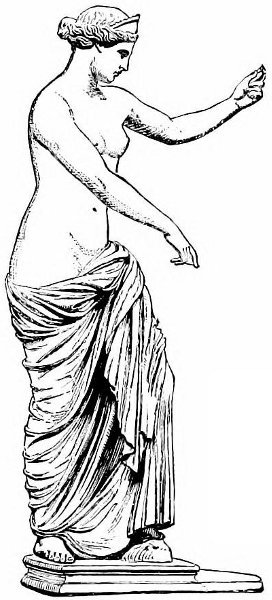
VENUS OF CAPUA.
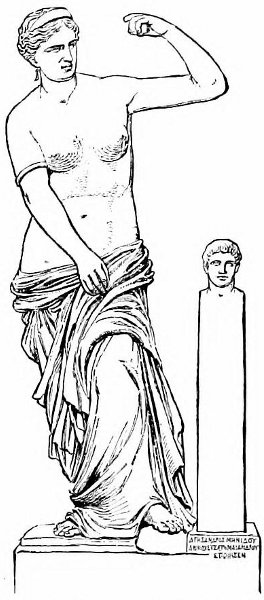
RESTORATION OF THE STATUE AS PROPOSED BY MR. TARRAL.
The patient German admirer of our statue, which Von Ravensburg is, has gone through all the literature and all the conjectures which it has given rise to, as to the chief problem which gives interest to any investigation, i. e., the restoration of the statue. No attempt will satisfy all the investigators; but that which Von Ravensburg accepts with approval—viz., the restoration of Mr. Tarral (an Englishman residing in Paris for many years, who has given his chief attention to this problem)—shows 91 so entire a want of appreciation of the character of antique design, which is, after all, our only clew, that I shall not hesitate to put aside, not only the solution proposed, but the judgment that could accept as satisfactory such a solution of one of the most interesting of artistic problems. I give the figure which Von Ravensburg publishes as Tarral’s restoration of the statue, that one may see how absolutely its inanity is at variance with the spirit of Greek design. The mere completion of the statue, in this sense, destroys the dignity and unity of the work so completely that to look at it is enough for a cultivated judgment to decide that, whatever it may have been, this it was not. The author gives, also, photographs of the fragments found—fragments so imperfect and corroded that we can only say that they appear to be from a very low period of art, and are utterly worthless as data for measure or opinion, from their extremely fragmentary state.

FRAGMENTS FOUND AT MELOS ATTRIBUTED TO THE STATUE.
Besides, I have shown, from the records of discovery, that there is no further reason to connect them with the statue than that they were also found at Melos.
In following the whole course of the demonstration which Von Ravensburg attempts of this solution of the problem, I arrive at the conclusion that, with all his patience and research, his judgment is utterly untrustworthy on a problem which requires not only freedom from preconception, but long cultivation of artistic perception and general critical ability. Mr. Tarral’s attempt proves, to my mind, only that this was not the solution.
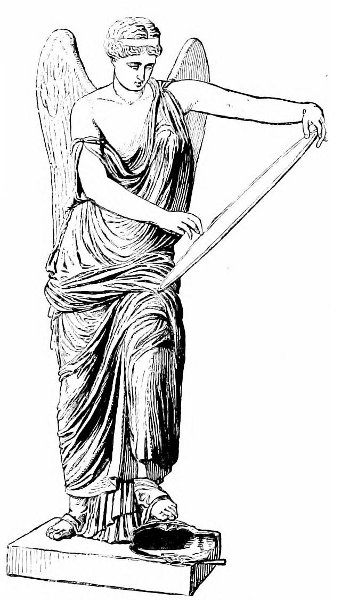
VICTORY OF BRESCIA—FRONT.
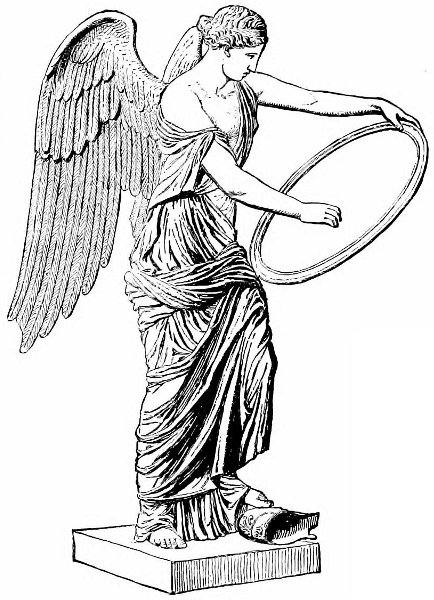
VICTORY OF BRESCIA—SIDE.
The various suggestions, more or less authoritative, made as to the restoration, and thence as to the determination of the attributes of the statue, are to be summed up briefly. The Count de Clarac, the then curator of the antiques of the Louvre, adopted the Venus with the apple hypothesis, but afterward abandoned it in favor of one put forward by Millingen, that it was a Victory. This is one of the theories of the restoration which has found the greatest number of adherents. Several restorations have been proposed, which make the statue part of a group, all which, though defended or proposed by many dilettanti, I reject, for what to me seem sufficient reasons, viz.: Firstly, we have in the statue no evidence whatever that it formed part of a group, and without some such the hypothesis is gratuitous; Secondly, we have—with one exception, which I shall presently note, and which gives no countenance to such a theory—no statue or parts of statues which agree with it in artistic quality, or 93 even none which lend themselves to a group, if such were made up by various sculptors; Thirdly, that, at the epoch in which the statue was produced, any group which has been suggested would have been out of accordance with the aims of art, as practiced by the Greeks. The only evidence in favor of such a theory is that in some antique fragments or coins are indications of such a figure as the Melian in combination. But, as this statue must have been in its own time nearly as celebrated, relatively, as in ours, it must have given rise to many imitations and adaptations. It may have given rise to some which support the group theory, but to more which support an opposing theory.
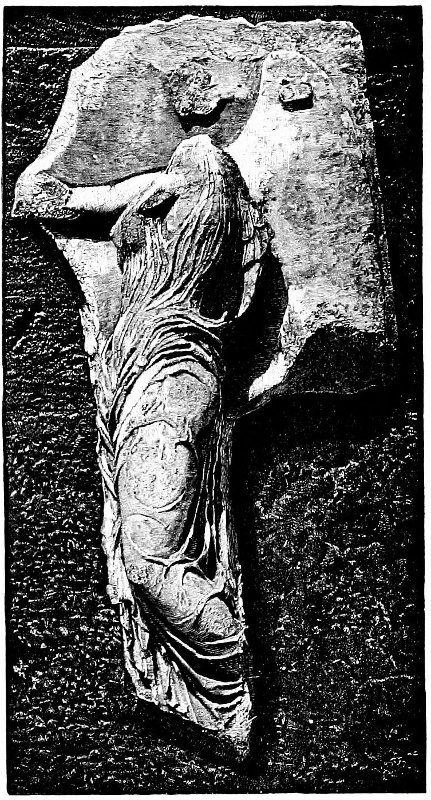
VICTORY RAISING AN OFFERING (TEMPLE OF NIKÉ APTEROS, THE ACROPOLIS, ATHENS).
Von Ravensburg goes over, in detail, all the group theories, and easily finds fatal objections to all. What most surprises me is that any one ever tried to put it into a group, so completely by itself does it stand in every sense of the word.
Millingen, in 1826, started his theory that it was a Victory holding a shield in both hands. I am quite convinced that many who have started other theories would have adopted this if they had not been anticipated in proposing it. The vanity of archæological research, and eagerness to propose something new is so dominant in most archæologists that 94 they exercise more ingenuity to advance some new theory than would be requisite to show the validity of an old one. And the statue of Melos has been preëminent in fruitfulness of theories of all qualities and grades of improbability. Millingen, however, supported his theory by a similar statue known as the Capuan Venus, a reproduction, I believe, in Roman times, of the Melian statue, probably through some other intermediate copy or reproduction, as the sculptors of the Capuan statue could not have seen the Melian. The arms are a modern and abominable restoration. Here, again, I must, in passing, protest against the attribution to the Venus type of all nude or semi-nude statues. There is nothing in the Capuan which indicates that it was intended as a Venus. Millingen quotes Apollonius of Rhodes as describing a statue of Venus looking at herself in the shield of Mars, which she herself is holding, but this is no evidence of the type correspondence, and the gravamen of the matter lies precisely in the diversity of the type from the recognizable Venuses. But the Capuan is too far in type and treatment from the Melian to serve as definite argument. Such as it is, an item in the discussion, I will not exaggerate its importance, though I believe it to be a far-away recollection of the Melian statue.
“The Victory of Brescia” is another of the recollections, rather than reproductions, of the type of which I believe the Melian statue to be the original. It is in bronze, is later, and has the wings, but the type is unmistakable, and the action of the torso and head is sufficiently different from our statue to show that it was only an emulation, and not a plagiarism, that was intended.
The drapery differs in the arrangement, being of bronze and agreeing with some undisputed Victories at Athens, but the action of the left leg holding the shield is the same, and that of the arms corresponds very nearly, as far as the arms remain 95 in the Melian work. As a whole, it reminds one more of the latter than does any other of the statues of its class.
The case is one in which archæological knowledge is of very little value, unless it be aided by thorough artistic study and a knowledge of the requirements of art proper. The archæologist, like other scientists, must have positive evidence to work on; and the testimony of pure taste, the intuitions of an artistic education, are of no use to him except as confirmatory. The intuition of the artist, whose taste has been educated by long study of the works he has to deal with, arrives at opinions by a kind of inspiration to which science often lacks all means of access. In the case of this statue, archæology has no evidence to weigh, and the ponderous erudition which Overbeck, Müller, Jahn, Welcker, and others have piled on the question has no foundation. We can determine with comparative certainty that the statue belongs to the epoch between Phidias and Praxiteles, because we have the work of the school of Phidias and sufficient comparative data for that of Praxiteles [and now, since the discovery of the Hermes at Olympia, positive data] to judge from; and we have a right to say that the Melian statue came between these, but beyond this nothing—no clew except what lies in the design and the unities attendant on it, of which per se the professed archæologist is no judge.
In working about the Acropolis of Athens some years ago, I photographed, amongst other sculptures, the mutilated Victories in the Temple of Niké Apteros, the “Wingless Victory,” the little Ionic temple in which stood that statue of Victory of which it is said that “the Athenians made her without wings that she might never leave Athens”; and looking at the photographs afterward, when the impression of the comparatively diminutive size had passed, I was struck with the close resemblance of the type to that of the “Venus” of Melos. There are the same large, heroic proportions, the same 96 ampleness in the development of the nude parts, the same art in the management of the draperies, and Richard Greenough, the American sculptor, has called my particular attention to the curious similarity in the treatment of the folds of the drapery, in the introduction of a plane between the folds, a resemblance not found in any other similar works as far as I know.
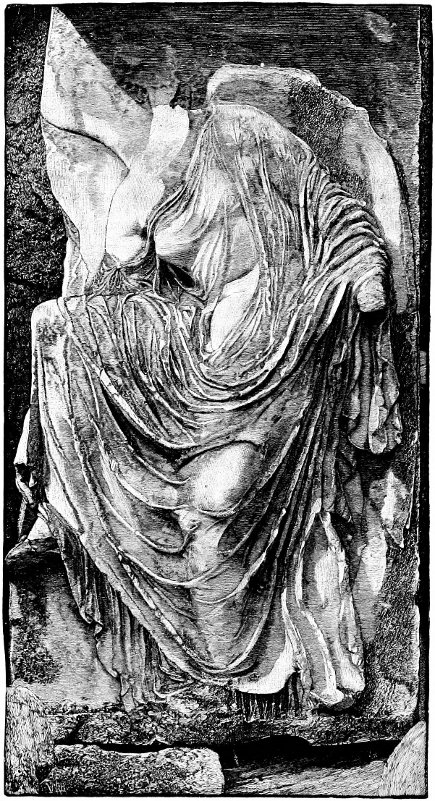
VICTORY UNTYING HER SANDAL (TEMPLE OF NIKÉ APTEROS, THE ACROPOLIS, ATHENS).
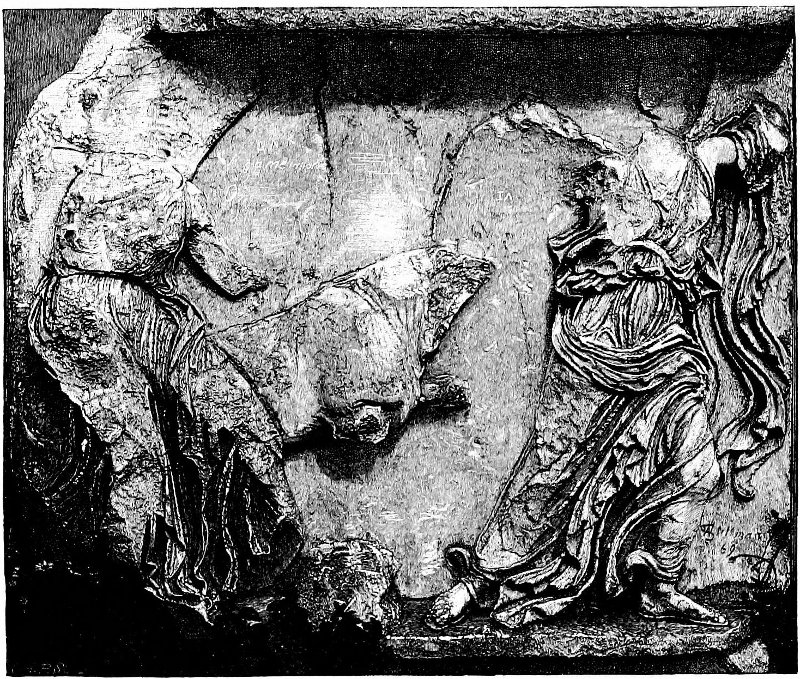
VICTORIES LEADING A BULL TO SACRIFICE (TEMPLE OF NIKÉ APTEROS, THE ACROPOLIS, ATHENS).
They are little high reliefs, part of a balustrade which surrounded the cortile of the Temple of Niké Apteros, hardly three feet high in their perfect state, and now without heads or hands or feet. There are four of them: one apparently untying her sandal; another,—that which best shows the type of the figure—raising an offering or crown, and two others leading a bull to sacrifice. I give the series. Note the exquisite composition of the drapery below the knee of the Victory raising the offering, and the superb flow of the entire draperies in the sandal-tying figure, but, above all, the Victory 98 type in the whole assemblage. How absolutely it agrees with that of the Melian statue, and how utterly alone in all antique art that is but for these!
Since I have begun this study, it has twice happened that artist friends trained in the French school (i. e., in the only school which cultivates the perception of style in design, and the only one that emulates the Greek in its characteristics), both trained draughtsmen, came into my room, and without any remark I showed them the photographs of the Victories at Athens. They were new to both, but in one case as in the other the first expression was: “How like the Venus of Melos!” And the similarity runs through the treatment of every part—the management of drapery to express the action of the limbs, the firm, heroic mould of the figure, and the modeling of the round contours. Compare (in the casts, if possible, as the small scale of my illustrations will not show the point so clearly) the right shoulder of the Venus with that in the stooping Victory. The slight differences which exist are just what might be expected between a figure which stands as principal, isolated, and to be seen from all sides, and one which was secondary, subordinate, of partial decorative use, and to be seen only in one view. My illustrations will hardly convey the strikingness of the similarity, but I defy any one to compare side by side the series of Victories and the Melian statue in casts and not admit that the type, the treatment, the ideal, are the same, as sisters may be the same, or at least as mother and daughter.
The little Temple of Niké Apteros had once, we know, a statue of Victory without wings, and we know the bon mot, which I have given above, which it suggested. The decorations of the temple are attributed to Scopas and his school, and this Victory was unique, so far as we know, in being wingless. We may well conceive, with the symbolical meaning—talismanic, rather—implied in what we know of it by 99 this witticism, that the Athenians would have a special anxiety to keep it from becoming a trophy in the hands of an enemy, even one who might not be disposed to desecrate the temples of the greater gods. Niké was rather an attribute or variation of Athena than a distinct goddess, and was as such both of great value to the Athenians, being the alter ego of their patroness; and of less reverence to the enemy, as not Minerva herself. At all events, when Pausanias visited Athens the Niké Apteros had gone. Her temple still stood there, and near it on the Acropolis hill stood some of the greatest art-treasures of the antique world untouched.
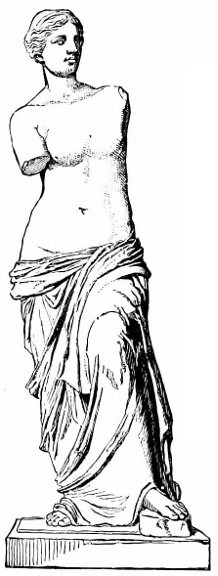
THE SO-CALLED VENUS OF MELOS—FRONT.
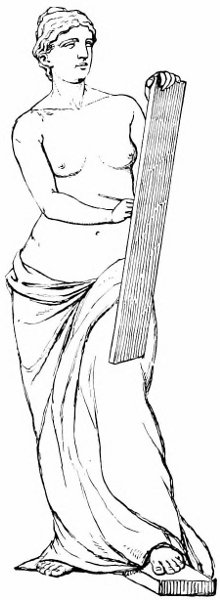
THE “VENUS” RESTORED—FRONT.
(TRACED FROM A PHOTOGRAPH OF A LIVING MODEL.)
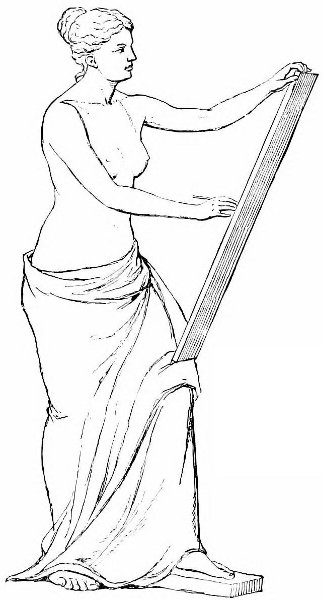
THE “VENUS” RESTORED—SIDE.
(TRACED FROM A PHOTOGRAPH OF A LIVING MODEL.)
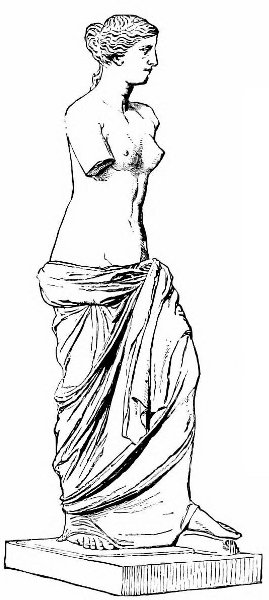
THE SO-CALLED VENUS OF MELOS—SIDE.
My theory, open to the grave objection that it is one in which hypothesis bears an undue proportion to proven fact (yet not so great as any of the group theories, and hardly more than any other theory, for all are constructed out of the same aerial substance), is that the Melian statue is the original Niké Apteros from the little temple on the Acropolis of Athens. If so, one can understand the whole of my theory of concealment, attribution, and type, because this statue above all others would come under the rancor of a victor and its flight would become an humiliation to Athens. It was like the standard of a defeated army, to be kept at all hazards from the enemy. Hurried away to Melos, it was safe from the invader, but no nearer point was secure. The restoration in my hypothesis becomes that of the Victory in some attitude connected with regarding, or recording, on the shield or a tablet the names of the Attic heroes, or battles, and my opinion is that she has just finished writing, but I am disposed to uncertainty on the exact phase of the action, only insisting on that of the Recorder. The minutiæ of description of many antique works of art which we owe to Pausanias and 101 Pliny was plainly impossible with this. Neither ever saw it, but its memory existed in artistic tradition and has been repeated in the statues we have seen, probably only a few of those which once existed.
Von Ravensburg sums up the objections to the shield-bearing Victory and to the theory of Millingen as follows: The theory would indicate that she leaned back to balance the weight of the shield, but the objections urged are that if the shield were larger it would hide too much (yet in an earlier part of the book the statement is made that a part of the figure, and just that part covered by the shield, is comparatively unfinished, which has given rise to the theory of a group in which one side of the statue was hidden); if it were small, the weight would not be enough to account for the attitude. And, in the next breath, he urges that the grand heroic character is an objection to her struggling with a burden. But if a goddess, and of this robust type, the burden ought not to oppress her, however great, humanly speaking. But in point of fact there is no noteworthy degree of backward inclination. To test the question, I photographed a model in the attitude required to hold a shield on her left knee and write on it.
The result was very slightly different from that of the statue. A part of the backward action of the model was due to the necessity of a support to enable her to remain in the pose necessary to be photographed, but the action of writing is better expressed by the statue.
The action of the statue is that of a figure which stands nearly balanced and in repose, with the first movement in a forward action, like one who reaches out to give, take, or write, or any similar action or the moment after the action is complete. The particular moment we cannot determine without the possession of the fore-arms. Von Ravensburg goes on to say that he does not mean to affirm that the holding of a 102 shield does not suit the action of the upper part of the body, but maintains that it does not explain it particularly well. But after the inane restoration given forth with his high approval, we may be permitted to doubt that his artistic taste has been as carefully developed as his archæological acumen. He quotes Overbeck as objecting to the shield resting on the left knee, that there are no traces on the left thigh which the shield must have left; but Wittig and Von Lützow have recognized these very marks, and they are distinctly visible even in the east, as far as would be expected if a bronze shield merely rested on the drapery, and the shield, if there was one, was in all probability of bronze, held well out from the body, and resting on the knee raised for that purpose, the foot being supported by a helmet lying on the ground. But, further, he says these considerations are quite superfluous, for the position of the left leg of the Melian statue contradicts the shield-supporting, and he quotes in support Valentin, that the left thigh would incline outward to secure a balance, and that the supporting of a heavy object on the thigh thrown in would violate the laws of equilibrium. That this is not true is shown by the “Victory of Brescia,” in which the action is precisely this, and the pose of the thigh is the same as that of the Melian statue. Moreover, I tried a model again in this view, and the result is given in the illustration.
The knee took quite readily the action indicated, and, indeed, would be compelled to by the pressure of the shield if the weight rested partly on the left hand, as it must to have left the right free for any action whatever. Both nature and the antique assert precisely the contrary to that which Valentin assumes. The length to which the argument against this restoration is carried by him may be judged from the assertion that the action of the “Victory of Brescia” is that of an outward push of the left thigh, to make it agree with that of 103 the theory Von Ravensburg lays down. But the assertion is purely gratuitous. If the Brescian bronze is an argument, as far as it goes it obviates every difficulty in the interpretation of the Melian statue by taking, so far as the action of the limbs is concerned, the very action of the latter.
There is but one objection to the restoration theory I propose which deserves serious consideration—that of the goddess looking off or above the point at which she would be writing if she were writing. Half the ingenuity displayed in many of the proposed restorations, or half the sophistry employed by Von Ravensburg to combat this, would carry us over much greater difficulties. In later Greek work, when art was sought for its own sake, and consistency continually sacrificed to the grace of a pose and harmony of the lines, we should not be surprised at the goddess looking at one point and writing at another; but at this period the dramatic unities were sacred alike in poetry as in art. But I suppose that, unlike the Brescian statue, she is not at the moment engaged in writing, but pausing as having just finished, and, looking out from her pedestal in the little temple, gazes out toward Marathon, in which direction the temple opens, and this is no difficulty in the restoration. A little of that kind of imagination so much abused in modern art-criticism, which consists in attributing to the artist all the fancies which arise in our minds in the contemplation of his work, all the far-fetched and poetic visions our own eyes have conjured up, would supply all deficiencies in our theory.
But while I maintain that my theory has more accordances with the known facts and actual qualities of the statue than any other, and presents fewer gaps in the demonstration, I am unwilling to lay down any theory not sustainable by what we know of Greek art, and I admit the difficulty as frankly as I state those of other theories. Doing so, however, I still maintain that not only is there the means of reconciliation of 104 my hypothesis of an actual shield-inscribing Victory with the statue as it is, but even in case I am compelled to abandon this particular point, and advocate the modification of Millingen that she holds the shield with both hands and looks at it, my main hypothesis—that the statue is a Victory and no Venus, and the particular wingless Victory of Athens—is untouched. We do not know what the Niké Apteros was doing. What we can see is that this statue was more probably holding a shield, either contemplatively, or pausing, just having written on it, than taking any other action.
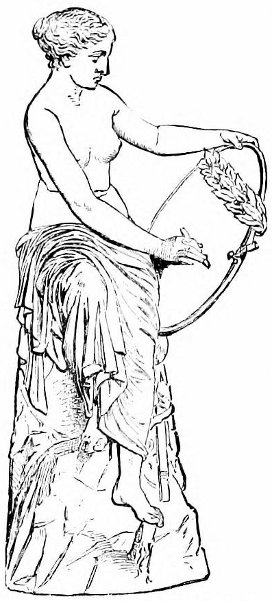
VICTORY OF CONSANI.
If we may accept the analogy of the Apollo Belvidere, which also looks off in the same inexplicable way, it would illustrate my hypothesis still further, but the Apollo is later and less dramatic. If we hold to the strict dramatic quality of the best Greek art, we must suppose that the goddess has just finished writing, and looks up and out toward the field where her heroes died. Or even if the shield was a high one, such as the Spartan wounded used to be brought home on, she might still be looking at the shield, if not at the words she has just written. In fact, several suggestions offer themselves, and none open to accusation of such flagrant inconsistencies as those involved in Tarral’s restoration, which shocks the dramatic sense beyond endurance.
The objection that the shield would hide so large a part of the figure goes for absolutely nothing. We continually find Greek work completely, or nearly, finished in positions where by necessity much of it must have been hidden. As the pediments of the Parthenon were originally placed, they would never have been half seen, and how the Panathenaic frieze could have been adequately seen, once the building 105 scaffolds were taken down, we can much less easily conjecture than how the Victory could have been seen behind her shield. The Brescian, a later and more realistic work, is seen behind hers. Consani has made a very happy emulation of the motive in his Victory. It is amongst the best of the modern Italian works of its class, and illustrates the manner of avoiding the difficulties we have seen adduced. The principal arguments in favor of my theory are these: The statue is not of the Venus type but on the contrary agrees distinctly with known statues of Victory, some of which I have indicated, of which another is in the coin of Agathocles, and in the Museum of Naples is a terra cotta Victory in almost the identical action and drapery; it is of the epoch of the Victories of the temple of Niké Apteros, and of the same style of treatment and type of figure; it was found where we might expect the Athenians to hide a treasure; and, while unquestionably a Victory, it is the only wingless Victory of the great Attic school we know of. I do not consider this archæological, but artistic demonstration.
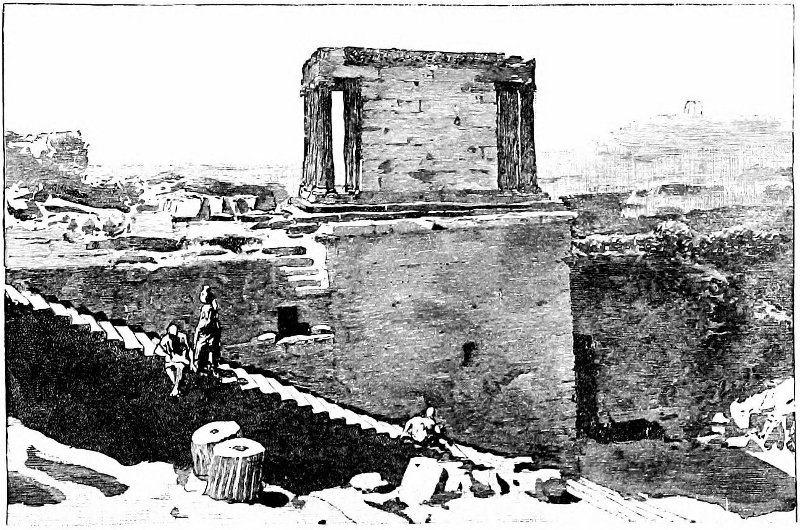
TEMPLE OF NIKÉ APTEROS.
The little Temple of Niké Apteros has had a destiny unique 106 amongst its kind. Like the Parthenon, it was standing little more than two hundred years ago, but during the Turkish occupation it was razed, and its stones all built into the great bastion which covered the front of the Acropolis and blocked up the staircase to the Propylæa. It was dug out and restored, nearly every stone in its place, by two German architects during the reign of Otho, and it stands again as Pausanias describes it, on the spot where old Ægeus watched for the return of Theseus from Crete, and seeing the black sails of his son’s ship returning, token of failure (for Theseus had forgotten to raise the white sail, the signal of success), threw himself from the precipice, and was dashed into black death on the rocks below. In the distance are Salamis and Ægina, and the straits through which the ships came from Melos and Crete, and to the south is Hymettus, beyond which are Marathon and the road by which the Persians came, and the Turks after them. There certainly was the spot, and this the occasion, if ever, that an Attic sculptor should feel that spiritual enthusiasm below which Greek art stopped and lost the clew which, in later centuries, the Florentine found again and followed to new, if not higher, heights.
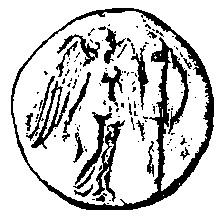
GREEK COIN